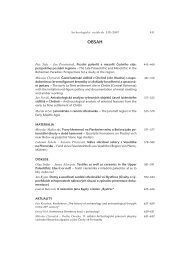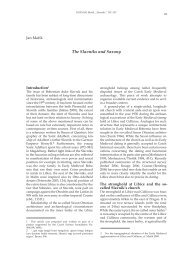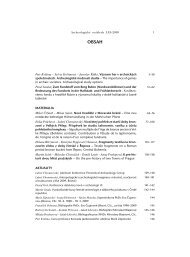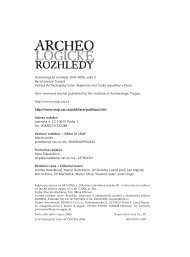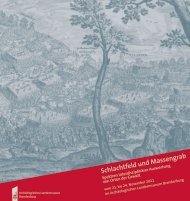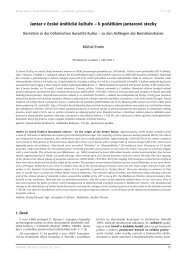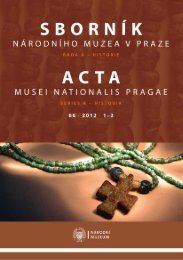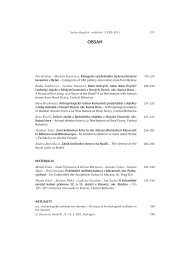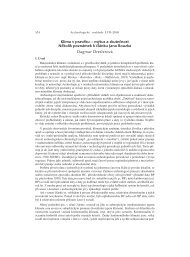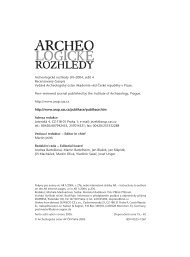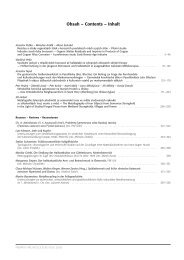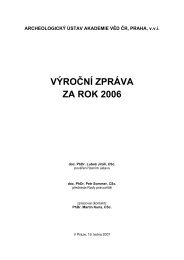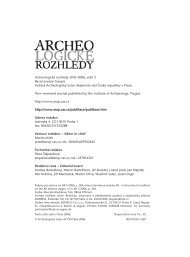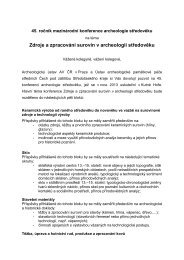Landscape Archaeology and 'Community Areas' in the Archaeology ...
Landscape Archaeology and 'Community Areas' in the Archaeology ...
Landscape Archaeology and 'Community Areas' in the Archaeology ...
You also want an ePaper? Increase the reach of your titles
YUMPU automatically turns print PDFs into web optimized ePapers that Google loves.
HICKS_Chapter-07.qxd 4/8/07 1:35 PM Page 146<br />
CHAPTER 7<br />
<strong>L<strong>and</strong>scape</strong> <strong>Archaeology</strong> <strong>and</strong> ‘Community<br />
Areas’ <strong>in</strong> <strong>the</strong> <strong>Archaeology</strong> of<br />
Central Europe<br />
Mart<strong>in</strong> Kuna <strong>and</strong> Dagmar Dreslerová<br />
<strong>L<strong>and</strong>scape</strong> is why people climb up to a view<strong>in</strong>g tower.<br />
— Jiří Sádlo, quoted by Storch 2002: 9<br />
The term<strong>in</strong>ology of 20th-century European archaeologists <strong>in</strong>cluded <strong>the</strong><br />
terms ‘space’, ‘environment’, ‘settlement’ <strong>and</strong> ‘l<strong>and</strong>scape’. These terms<br />
are closely <strong>in</strong>terrelated: <strong>the</strong>y can be treated as synonyms, <strong>the</strong>ir mean<strong>in</strong>gs<br />
can overlap or <strong>the</strong>y can be def<strong>in</strong>ed as quite separate concepts. Their<br />
mean<strong>in</strong>gs change accord<strong>in</strong>g to <strong>the</strong> traditions of use <strong>in</strong> various regional<br />
<strong>and</strong> period-based communities of archaeologists, as well as under <strong>the</strong><br />
<strong>in</strong>fluence of shift<strong>in</strong>g discipl<strong>in</strong>ary paradigms. Our focus <strong>in</strong> this chapter is<br />
on how approaches to ‘l<strong>and</strong>scape’ have changed <strong>in</strong> <strong>the</strong> archaeology of<br />
central Europe, draw<strong>in</strong>g upon archaeological material from <strong>the</strong> Czech<br />
Republic, Pol<strong>and</strong> <strong>and</strong> Germany. We explore <strong>the</strong> chang<strong>in</strong>g approaches to<br />
‘settlement’ <strong>in</strong> central European archaeology, <strong>in</strong>troduc<strong>in</strong>g <strong>the</strong> concepts<br />
of L<strong>and</strong>esaufnahme <strong>and</strong> Siedlungskammer, <strong>and</strong> Neustupný <strong>and</strong> Kuna’s<br />
notion of ‘community areas’. We shall <strong>the</strong>n discuss how <strong>the</strong> idea of<br />
‘community areas’ can be used to trace <strong>the</strong> relationships between identity<br />
<strong>and</strong> l<strong>and</strong>scape <strong>in</strong> central European prehistory through two case<br />
studies, exam<strong>in</strong><strong>in</strong>g an Iron Age <strong>in</strong>dustrial zone <strong>and</strong> Bronze Age burial<br />
mounds <strong>in</strong> l<strong>and</strong>scape perspective. By do<strong>in</strong>g so, we hope to demonstrate<br />
<strong>the</strong> dist<strong>in</strong>ctive way <strong>in</strong> which <strong>the</strong> archaeology of l<strong>and</strong>scapes has been<br />
approached <strong>in</strong> <strong>the</strong> study of <strong>the</strong> later prehistory of central Europe.<br />
SPACE, SETTLEMENT AND LANDSCAPE IN CENTRAL<br />
EUROPEAN ARCHAEOLOGY<br />
The archaeological l<strong>and</strong>scapes of central Europe range from Upper<br />
Palaeolithic sites at <strong>the</strong> foot of <strong>the</strong> South Moravian hills <strong>in</strong> <strong>the</strong> eastern<br />
Czech Republic to <strong>the</strong> chang<strong>in</strong>g l<strong>and</strong>scapes of <strong>the</strong> Neolithic <strong>and</strong><br />
Chalcolithic (Sherratt 1981); Corded Ware <strong>and</strong> Bell Beaker sites; Celtic<br />
146
HICKS_Chapter-07.qxd 4/8/07 1:35 PM Page 147<br />
<strong>L<strong>and</strong>scape</strong> <strong>Archaeology</strong> <strong>and</strong> ‘Community Areas’ 147<br />
hill forts, medieval field boundaries <strong>and</strong> deserted villages; 19th-century<br />
<strong>in</strong>dustrial l<strong>and</strong>scapes; <strong>and</strong> <strong>the</strong> rema<strong>in</strong>s of 20th-century collectivisation<br />
<strong>and</strong> <strong>in</strong>dustrialisation programmes, opencast coal m<strong>in</strong><strong>in</strong>g, factories <strong>and</strong><br />
motorways. A variety of spatial approaches, with a diversity of methods<br />
<strong>and</strong> aims, have been employed <strong>in</strong> <strong>the</strong> region.<br />
The earliest attempts to study archaeological material <strong>in</strong> relation to<br />
geographical space <strong>in</strong> central Europe developed <strong>in</strong> <strong>the</strong> culture historical<br />
approaches of <strong>the</strong> early 20th century. The German prehistorian<br />
Gustav Koss<strong>in</strong>a (1858–1931) was one of its foremost proponents, with<br />
his Siedlungsarchäologie (settlement archaeology), which focused on<br />
<strong>the</strong> ethnic dimension of spatial distribution of archaeological sites<br />
(Koss<strong>in</strong>a 1911). The culture historical approach developed ever more<br />
detailed typologies <strong>and</strong> chronologies of archaeological cultures.<br />
Geography <strong>and</strong> l<strong>and</strong>scape were used to identify <strong>in</strong>dividual social <strong>and</strong><br />
political groups <strong>in</strong> <strong>the</strong> archaeological record, <strong>and</strong> to highlight migrations<br />
from ‘homel<strong>and</strong>s’ that were analogous to conventional historical<br />
accounts of geopolitical events. Similar approaches were common<br />
<strong>in</strong> o<strong>the</strong>r European countries at that time <strong>and</strong> even later, such as <strong>the</strong><br />
school developed by Koss<strong>in</strong>a’s student Józef Kostrzewski at Poznañ<br />
University <strong>in</strong> Pol<strong>and</strong> (Kostrzewski 1949), <strong>and</strong> many archaeologists <strong>in</strong><br />
Czechoslovakia, e.g. Jaroslav Böhm (1937, 1941) <strong>and</strong> Jan Filip (1956).<br />
Occasionally, culture historical approaches led to nationalistic<br />
excesses <strong>and</strong> political manipulations: most notoriously <strong>in</strong> <strong>the</strong> appropriation<br />
of Koss<strong>in</strong>a’s attempts to def<strong>in</strong>e <strong>the</strong> primacy of German culture<br />
<strong>in</strong> Europe by <strong>the</strong> Nazis (e.g. Mähl<strong>in</strong>g 1944). But such perspectives<br />
were not necessarily an <strong>in</strong>tegral part of culture history. The culture<br />
historical paradigm has survived across central European archaeology<br />
<strong>in</strong> a moderated form until today, <strong>and</strong> <strong>the</strong> <strong>in</strong>fluence of culture<br />
historical <strong>in</strong>terpretive frameworks cont<strong>in</strong>ues to be significant.<br />
The gradual dissolution of Koss<strong>in</strong>a’s concept of settlement archaeology<br />
began <strong>in</strong> central Europe dur<strong>in</strong>g <strong>the</strong> 1940s <strong>and</strong> 1950s, with<br />
<strong>the</strong> work of German scholars such as Ernst Wahle (1941) <strong>and</strong> Hans<br />
J. Eggers (1950). These scholars argued that ethnic reasons alone did<br />
not expla<strong>in</strong> <strong>the</strong> spatial organisation of archaeological cultures <strong>and</strong> that<br />
a range of o<strong>the</strong>r explanations (socio-economic, political, ritual) were<br />
required. Later, Herbert Jankuhn (1955, 1977) revised Koss<strong>in</strong>a’s approaches,<br />
<strong>and</strong> his work produced a school of thought with a new <strong>the</strong>oretical<br />
framework. Jankuhn reta<strong>in</strong>ed <strong>the</strong> term Siedlungsarchäologie,<br />
but sought to exam<strong>in</strong>e <strong>the</strong> relationships of past settlements with <strong>the</strong><br />
natural environment, demography <strong>and</strong> socio-economic relationships,<br />
ra<strong>the</strong>r than just engag<strong>in</strong>g <strong>in</strong> ‘ethnic’ <strong>in</strong>terpretations. Spatial relationships<br />
between archaeological sites, <strong>the</strong> natural environment <strong>and</strong> remnants<br />
of settlement activities were emphasised <strong>in</strong> studies that made<br />
use of a range of methodologies: <strong>the</strong> analysis of geological <strong>and</strong> soil
HICKS_Chapter-07.qxd 4/8/07 1:35 PM Page 148<br />
148 Chapter 7<br />
maps, palynological <strong>and</strong> climatic data, <strong>and</strong> <strong>the</strong> density of settlement<br />
units <strong>in</strong> space.<br />
Slightly later, between <strong>the</strong> 1950s <strong>and</strong> 1960s, similar approaches to<br />
settlement <strong>and</strong> archaeology emerged <strong>in</strong> <strong>the</strong> United States. A significant<br />
asset of <strong>the</strong> American school was conta<strong>in</strong>ed with<strong>in</strong> <strong>the</strong> concept of ‘settlement<br />
pattern’ – <strong>the</strong> layout of past settlements, conta<strong>in</strong><strong>in</strong>g evidence of<br />
<strong>the</strong>ir socio-economic systems (Willey 1953; Chang 1968). The term ‘settlement<br />
pattern’, whe<strong>the</strong>r adopted directly from Willey <strong>and</strong> Chang, or<br />
from those <strong>in</strong>fluenced by <strong>the</strong>ir work, percolated <strong>in</strong>to European archaeology<br />
after <strong>the</strong> 1960s <strong>in</strong> <strong>in</strong>numerable partial mean<strong>in</strong>gs <strong>and</strong> contexts.<br />
The extent of <strong>in</strong>tellectual exchanges between central European <strong>and</strong><br />
American schools of settlement archaeology dur<strong>in</strong>g <strong>the</strong> 1950s is<br />
unclear. However, references to central European approaches are not to<br />
be found <strong>in</strong> <strong>the</strong> classic statements of ei<strong>the</strong>r American (e.g. Chang 1968)<br />
or German versions of settlement archaeology (e.g. Jankuhn 1977) dur<strong>in</strong>g<br />
<strong>the</strong> 1960s <strong>and</strong> 1970s. The processes through which ideas of settlement<br />
archaeology developed <strong>the</strong>refore rema<strong>in</strong>s an <strong>in</strong>terest<strong>in</strong>g target for<br />
future research <strong>in</strong>to <strong>the</strong> history of thought <strong>in</strong> world archaeology.<br />
Central European approaches to l<strong>and</strong>scape were, however, significantly<br />
<strong>in</strong>fluenced by <strong>the</strong> spatial archaeology formulated <strong>in</strong> Brita<strong>in</strong> by<br />
David Clarke. Clarke drew upon <strong>the</strong> New Geography to develop both<br />
methods <strong>and</strong> <strong>the</strong>oretical frameworks for <strong>the</strong> archaeological study of<br />
spatial relationships (Clarke 1977). The spatial organization of archaeological<br />
data was studied at various levels – from a s<strong>in</strong>gle assemblage<br />
to an archaeological culture. Spatial archaeology enriched <strong>the</strong> discipl<strong>in</strong>e<br />
with several valuable methods <strong>and</strong> models, such as site-catchment<br />
analysis, flow-off curves, etc., but as a general <strong>the</strong>oretical model it<br />
never<strong>the</strong>less gradually became unfashionable dur<strong>in</strong>g <strong>the</strong> 1980s. This<br />
occurred ma<strong>in</strong>ly under <strong>the</strong> pressure <strong>and</strong> <strong>in</strong>fluence exerted by ano<strong>the</strong>r<br />
approach, also orig<strong>in</strong>at<strong>in</strong>g <strong>in</strong> Brita<strong>in</strong>, which did not bow to <strong>the</strong> exact<br />
methodology <strong>and</strong> economic <strong>in</strong>terpretations of spatial archaeology, but<br />
preferred a hermeneutic approach to archaeological material – symbolic<br />
archaeology, later to be known as post-processual archaeology.<br />
However, as British scholars were mov<strong>in</strong>g away from <strong>the</strong> term, <strong>in</strong><br />
Czech archaeology spatial archaeology was revitalised <strong>in</strong> <strong>the</strong> 1990s<br />
with <strong>the</strong> work of Evžen Neustupný (1991, 1998a). As with earlier British<br />
approaches to spatial archaeology, Neustupný argued that space forms<br />
an important aspect of <strong>the</strong> archaeological evidence, which should be<br />
analysed next to <strong>the</strong> aspects of its (artefactual) form. In a sense,<br />
Neustupný’s spatial archaeology is a conceptual ant<strong>in</strong>omy <strong>and</strong> supplement<br />
of <strong>the</strong> typology of artefacts – that is, archaeology that studies <strong>the</strong><br />
formal characteristics of <strong>the</strong> data. General spatial characteristics <strong>and</strong><br />
spatial units of archaeological sources have been formulated <strong>in</strong><br />
Neustupný’s <strong>the</strong>ory of community areas.
HICKS_Chapter-07.qxd 4/8/07 1:35 PM Page 149<br />
<strong>L<strong>and</strong>scape</strong> <strong>Archaeology</strong> <strong>and</strong> ‘Community Areas’ 149<br />
In central Europe, l<strong>and</strong>scape archaeology was also developed by<br />
avocational archaeologists – for example, <strong>in</strong> <strong>the</strong> development of research<br />
on deserted medieval villages <strong>and</strong> medieval field systems by Czech<br />
physician Ervín Černý (1973, 1979). Such approaches developed a concept<br />
of l<strong>and</strong>scape as reveal<strong>in</strong>g an object of study outside <strong>the</strong> ‘site’ (which<br />
<strong>in</strong> central European prehistory were often simply rich concentrations of<br />
artefacts). It was clear that <strong>the</strong> areas between <strong>the</strong> dist<strong>in</strong>ct sites (settlements<br />
<strong>and</strong> burial grounds) also held archaeological potential, although<br />
often of a different nature from those found on more visible ‘sites’. As <strong>in</strong><br />
Brita<strong>in</strong>, so <strong>in</strong> central Europe this was particularly significant for <strong>the</strong><br />
recognition of l<strong>and</strong>scape features such as field boundaries, enclosures of<br />
various functions, remnants of quarry<strong>in</strong>g <strong>and</strong> process<strong>in</strong>g raw materials,<br />
etc. These artefacts <strong>and</strong> ecofacts were often difficult to date, result<strong>in</strong>g <strong>in</strong><br />
<strong>the</strong>ir long-last<strong>in</strong>g neglect by previous archaeological schools <strong>in</strong> central<br />
Europe, which presumed chronology to be <strong>the</strong> ma<strong>in</strong> aim of archaeological<br />
knowledge. With<strong>in</strong> <strong>the</strong> new conceptual framework, however, <strong>the</strong><br />
concept of l<strong>and</strong>scape (<strong>in</strong> <strong>the</strong> sense mentioned above) brought a new<br />
<strong>in</strong>sight to archaeology. Firstly, it showed that <strong>the</strong> geographical space<br />
was used cont<strong>in</strong>ually <strong>and</strong> not just at <strong>the</strong> selected loci, <strong>and</strong> that this cont<strong>in</strong>uity<br />
of use is reflected <strong>in</strong> <strong>the</strong> spatial cont<strong>in</strong>uity of archaeological data<br />
(components). Secondly, it showed that spatial cont<strong>in</strong>uity could be <strong>in</strong>terpreted<br />
as <strong>the</strong> cont<strong>in</strong>uity of complementary functions – most settlements,<br />
for example, must have been associated with arable fields, paths, burial<br />
grounds <strong>and</strong> pastures. Consequently, <strong>the</strong> underst<strong>and</strong><strong>in</strong>g of past communities<br />
has become more complex than had so far been realised.<br />
Thirdly, archaeology’s capability of study<strong>in</strong>g large objects of anthropogenic<br />
orig<strong>in</strong> altered <strong>the</strong> concept of <strong>the</strong> surround<strong>in</strong>g material world as<br />
a whole: it has become clear that man was not only <strong>in</strong>fluenced by his<br />
environment, but often also impacted upon it <strong>and</strong> re-created it. Ra<strong>the</strong>r<br />
than th<strong>in</strong>k<strong>in</strong>g of humans adapt<strong>in</strong>g to <strong>the</strong> environment, <strong>the</strong> emphasis<br />
shifted to human <strong>in</strong>teraction with <strong>the</strong> environment (Zvelebil et al. 1993;<br />
Zvelebil 1994), <strong>and</strong> its adaptation to human uses (Neustupný <strong>in</strong> prep.).<br />
F<strong>in</strong>ally, <strong>the</strong> fact that archaeological features are still part of <strong>the</strong> l<strong>and</strong>scape<br />
illustrates a fur<strong>the</strong>r characteristic of <strong>the</strong> l<strong>and</strong>scape: cont<strong>in</strong>uity <strong>in</strong> time.<br />
Individual people <strong>and</strong> <strong>the</strong>ir settlements can relatively easily appear <strong>and</strong><br />
disappear, while <strong>the</strong> l<strong>and</strong>scape, although transformed by man <strong>and</strong><br />
nature, cannot. All processes <strong>in</strong> <strong>the</strong> l<strong>and</strong>scape relate to <strong>the</strong> state of <strong>the</strong><br />
previous period <strong>and</strong> previous generations of its <strong>in</strong>habitants – <strong>in</strong> this<br />
sense l<strong>and</strong>scape has a memory. Erasure of that memory can be achieved<br />
only by drastic means, such as <strong>the</strong> surface m<strong>in</strong><strong>in</strong>g of brown coal <strong>in</strong><br />
northwestern Bohemia dur<strong>in</strong>g <strong>the</strong> communist period, or <strong>the</strong> build<strong>in</strong>g of<br />
<strong>the</strong> Three Gorges Dam <strong>in</strong> Ch<strong>in</strong>a today.<br />
In contemporary archaeology, l<strong>and</strong>scape is often understood not<br />
only as a concept complementary to ‘sites’, but also as an overarch<strong>in</strong>g
HICKS_Chapter-07.qxd 4/8/07 1:35 PM Page 150<br />
150 Chapter 7<br />
approach to multiple scales of analysis – from site to region. This is<br />
also how <strong>the</strong> term l<strong>and</strong>scape has been used <strong>in</strong> <strong>the</strong> German l<strong>and</strong>scape<br />
archaeology (L<strong>and</strong>schaftsarchäologie) s<strong>in</strong>ce <strong>the</strong> mid-1990s (Lün<strong>in</strong>g 1997;<br />
Gramsch 2003). Accord<strong>in</strong>g to Andreas Zimmerman (2003; Zimmermann<br />
et al. 2004), l<strong>and</strong>scape archaeology represents <strong>the</strong> research of <strong>the</strong> spatial<br />
organisation of human activity above <strong>the</strong> level of <strong>in</strong>dividual sites or<br />
communities, while emphasis<strong>in</strong>g <strong>the</strong> structure <strong>and</strong> function of l<strong>and</strong>scape<br />
components (understood generally as settlement components).<br />
In his two sem<strong>in</strong>al studies on <strong>the</strong> prehistoric settlement (ma<strong>in</strong>ly<br />
Neolithic, excavated <strong>in</strong> <strong>the</strong> opencast m<strong>in</strong><strong>in</strong>g areas) <strong>in</strong> <strong>the</strong> Rh<strong>in</strong>el<strong>and</strong>,<br />
Zimmermann <strong>and</strong> his colleagues provide evidence for aspects of l<strong>and</strong>scape<br />
archaeology <strong>in</strong> two spheres: settlement history reconstruct<strong>in</strong>g <strong>the</strong><br />
development of <strong>the</strong> area under study to <strong>the</strong> scale of <strong>in</strong>dividual villages<br />
<strong>and</strong> generations of <strong>the</strong>ir <strong>in</strong>habitants, <strong>and</strong> <strong>the</strong> study of settlement structure<br />
on various scales. As exemplary questions of l<strong>and</strong>scape archaeology,<br />
<strong>in</strong> this sense <strong>the</strong> author considers settlement density, demographic<br />
trends, circulation of raw materials, hierarchy of settlement units <strong>and</strong><br />
similar.<br />
We suggest here that <strong>the</strong> term ‘l<strong>and</strong>scape’ can <strong>in</strong>corporate one crucial<br />
element which is not considered by <strong>the</strong> contemporary German<br />
model of L<strong>and</strong>schaftsarchäologie, <strong>and</strong> which is often missed <strong>in</strong> settlement<br />
<strong>and</strong> environmental archaeologies <strong>in</strong> general: unlike <strong>the</strong> ‘natural<br />
environment’, ‘l<strong>and</strong>scape’ is <strong>in</strong>divisible from human be<strong>in</strong>gs <strong>and</strong> <strong>the</strong>ir<br />
cognitive activities. Human be<strong>in</strong>gs not only <strong>in</strong>teract with <strong>the</strong> environment<br />
through materials, but <strong>the</strong>y also perceive <strong>and</strong> <strong>in</strong>terpret it, <strong>and</strong> <strong>the</strong><br />
part of <strong>the</strong> environment which can be perceived <strong>and</strong> given mean<strong>in</strong>g by<br />
people is <strong>in</strong>corporated with<strong>in</strong> <strong>the</strong> idea of ‘l<strong>and</strong>scape’. The idea of l<strong>and</strong>scape,<br />
<strong>the</strong>n, can be used to capture how <strong>the</strong> physical environment is<br />
manipulated by people <strong>in</strong> a symbolic as well as a practical way. We<br />
naturally assume that this manipulation existed <strong>in</strong> <strong>the</strong> past, too, <strong>and</strong><br />
should have left traces <strong>in</strong> <strong>the</strong> archaeological record. Therefore, we see<br />
<strong>the</strong> aim of l<strong>and</strong>scape archaeology as be<strong>in</strong>g a process of reconstruction<br />
of l<strong>and</strong>scape elements or larger parts of l<strong>and</strong>scape <strong>in</strong> <strong>the</strong> past that<br />
works upon <strong>the</strong> identifiable <strong>and</strong> <strong>in</strong>terpretable impr<strong>in</strong>t of human activity<br />
<strong>in</strong> both its practical <strong>and</strong> symbolic aspects.<br />
SETTLEMENT AND LANDSCAPE ARCHAEOLOGY IN<br />
CENTRAL EUROPE<br />
In this section, we exam<strong>in</strong>e how archaeologies of settlement <strong>and</strong> l<strong>and</strong>scape<br />
have developed <strong>in</strong> central Europe, <strong>in</strong>troduc<strong>in</strong>g several <strong>in</strong>fluential<br />
concepts (L<strong>and</strong>esaufnahme, microregions, community area <strong>the</strong>ory) <strong>and</strong><br />
methods (analytical survey, predictive modell<strong>in</strong>g). However, before<br />
<strong>in</strong>troduc<strong>in</strong>g <strong>the</strong>se concepts, it is important to underl<strong>in</strong>e some of <strong>the</strong>
HICKS_Chapter-07.qxd 4/8/07 1:35 PM Page 151<br />
<strong>L<strong>and</strong>scape</strong> <strong>Archaeology</strong> <strong>and</strong> ‘Community Areas’ 151<br />
particular <strong>in</strong>fluences upon <strong>the</strong> development of central European settlement<br />
<strong>and</strong> l<strong>and</strong>scape archaeologies <strong>in</strong> this region – s<strong>in</strong>ce <strong>the</strong> character of<br />
<strong>the</strong> central European archaeological record has shaped how archaeologists<br />
<strong>in</strong> <strong>the</strong> region have developed <strong>and</strong> used ideas of l<strong>and</strong>scape.<br />
Today, l<strong>and</strong>scape archaeology <strong>in</strong> central Europe presents a number<br />
of challenges, not only because of <strong>the</strong> <strong>in</strong>fluence of culture history or<br />
Jankuhn’s settlement archaeology on research <strong>in</strong> <strong>the</strong> region, but also<br />
due to <strong>the</strong> ongo<strong>in</strong>g destruction of <strong>the</strong> archaeological l<strong>and</strong>scape<br />
through <strong>in</strong>tensive arable agriculture, which cont<strong>in</strong>ues a process that<br />
began with medieval <strong>and</strong> post-medieval clearance <strong>and</strong> leaves just<br />
small areas of pasture <strong>and</strong> woodl<strong>and</strong> <strong>in</strong> which elements of past l<strong>and</strong>scapes<br />
survive above ground. Apart from hill forts or medieval field<br />
systems, above-ground earthwork features – whe<strong>the</strong>r from <strong>the</strong> prehistoric<br />
or medieval periods – are rare <strong>in</strong> <strong>the</strong> central European l<strong>and</strong>scape.<br />
Ano<strong>the</strong>r specific problem is <strong>the</strong> low frequency of artefacts<br />
made of durable materials such as fl<strong>in</strong>t. Whereas surface collection <strong>in</strong><br />
sou<strong>the</strong>rn Engl<strong>and</strong> can recover thous<strong>and</strong>s of fl<strong>in</strong>t tools <strong>and</strong> débitage<br />
dur<strong>in</strong>g a short field survey project, but very few sherds of prehistoric<br />
ceramics (Shennan 1985), <strong>the</strong> situation <strong>in</strong> central Bohemia is quite <strong>the</strong><br />
opposite. For example, dur<strong>in</strong>g <strong>the</strong> British-Czech Ancient <strong>L<strong>and</strong>scape</strong><br />
Reconstruction (ALRB) project <strong>in</strong> Bohemia approximately 30,000 fragments<br />
of prehistoric pottery were found dur<strong>in</strong>g <strong>the</strong> five collection<br />
campaigns, contrast<strong>in</strong>g with only approximately 600 items of fl<strong>in</strong>t,<br />
<strong>in</strong>clud<strong>in</strong>g Palaeolithic material <strong>and</strong> post-medieval strike-a-lights, <strong>and</strong><br />
even fewer o<strong>the</strong>r durable items (fragments of stone axes, prehistoric<br />
glass or metals) (Kuna 1994, 1998, 2000).<br />
Comparison of settlement densities <strong>in</strong> various prehistoric periods is<br />
not without its pitfalls, too. As already mentioned, <strong>the</strong> probability of<br />
f<strong>in</strong>d<strong>in</strong>g a prehistoric settlement depends directly on def<strong>in</strong><strong>in</strong>g subsurface<br />
archaeological features. For example, <strong>the</strong> period of Corded Ware<br />
(Late Eneolithic <strong>in</strong> <strong>the</strong> Czech term<strong>in</strong>ology, 2900–2500 cal. BC) is not<br />
characterised by <strong>the</strong> presence of sub-surface features such as houses or<br />
storage pits, <strong>and</strong> <strong>the</strong>refore not a s<strong>in</strong>gle settlement site is known <strong>in</strong> <strong>the</strong><br />
Czech Republic from this period – whereas very many Corded Ware<br />
cemeteries survive. This poses particular challenges for l<strong>and</strong>scape<br />
archaeology. One answer is to maximize <strong>the</strong> exploitation of <strong>the</strong> evidence<br />
available. For example, a detailed analysis of residual pottery<br />
fragments, which previously had not received analytical attention, has<br />
recently been undertaken. The results of this research surpris<strong>in</strong>gly<br />
revealed that <strong>the</strong>re were more periods represented, often almost <strong>the</strong>ir<br />
complete spectrum, on most prehistoric settlement sites than had been<br />
recorded by st<strong>and</strong>ard excavation methodology (Kuna 2002). This example<br />
is a warn<strong>in</strong>g aga<strong>in</strong>st premature conclusions concern<strong>in</strong>g <strong>the</strong> density<br />
of prehistoric settlements on <strong>the</strong> basis of st<strong>and</strong>ard field data.
HICKS_Chapter-07.qxd 4/8/07 1:35 PM Page 152<br />
152 Chapter 7<br />
The central European archaeological resource also presents particular<br />
advantages, however. For example, <strong>in</strong> some periods ceramics from<br />
prehistoric settlements <strong>and</strong> cemeteries are so abundant <strong>and</strong> typologically<br />
dist<strong>in</strong>ctive that assemblages can be sorted <strong>in</strong>to very f<strong>in</strong>egra<strong>in</strong>ed<br />
phases. As reflected <strong>in</strong> <strong>the</strong> analysis of Neolithic settlements <strong>in</strong><br />
both Germany <strong>and</strong> Bohemia, by us<strong>in</strong>g this data <strong>the</strong> development of<br />
<strong>in</strong>dividual settlements <strong>and</strong> microregions can be detailed down to<br />
almost <strong>in</strong>dividual generations of <strong>the</strong>ir <strong>in</strong>habitants. Such clarity <strong>in</strong> prehistory<br />
can only be surpassed by some of <strong>the</strong> dendrochronologically<br />
dated sites of <strong>the</strong> Alp<strong>in</strong>e region.<br />
L<strong>and</strong>esaufnahme<br />
The first concept that we want to <strong>in</strong>troduce, that of archäologische<br />
L<strong>and</strong>esaufnahme (‘archaeological area scan’), has played an important<br />
role <strong>in</strong> <strong>the</strong> development of central European l<strong>and</strong>scape archaeology<br />
s<strong>in</strong>ce <strong>the</strong> 1960s. L<strong>and</strong>esaufnahme <strong>in</strong>volves <strong>the</strong> systematic collection of all<br />
archaeological data with<strong>in</strong> <strong>the</strong> maximum possible chronological span<br />
from <strong>the</strong> region under study. All <strong>the</strong> possible resources are used:<br />
museum collections, sites <strong>and</strong> monument records <strong>and</strong> published archaeological<br />
literature are comb<strong>in</strong>ed with new data generated through systematic<br />
field surveys. The cartographic visualization of <strong>the</strong>se data<br />
creates an <strong>in</strong>tegrated overview of <strong>the</strong> l<strong>and</strong>scape which serves as a source<br />
for <strong>the</strong>oretical research <strong>and</strong> effective heritage management.<br />
The term archäologische L<strong>and</strong>esaufnahme was first used by Karl He<strong>in</strong>z<br />
Jakob <strong>in</strong> 1908, <strong>and</strong> was fur<strong>the</strong>r developed between <strong>the</strong> wars by o<strong>the</strong>r<br />
German archaeologists (Alfred Tode, Albert Kiekebusch, Karl Kersten).<br />
It was Herbert Jankuhn (1973), however, who def<strong>in</strong>ed it as a pr<strong>in</strong>cipal<br />
method of settlement archaeology. In 1978, it was adopted <strong>in</strong> Pol<strong>and</strong> by<br />
an ambitious project, Archeologiczne Zdjęcie Polski (Archaeological Record<br />
of Pol<strong>and</strong>), for mapp<strong>in</strong>g <strong>the</strong> whole state territory (Mazurowski 1980)<br />
that cont<strong>in</strong>ues to this day. Comb<strong>in</strong><strong>in</strong>g fieldwalk<strong>in</strong>g <strong>and</strong> documentary<br />
research on <strong>the</strong> st<strong>and</strong><strong>in</strong>g monuments, it has now covered approximately<br />
75% of <strong>the</strong> country <strong>and</strong> has registered some 290,000 archaeological sites<br />
(Barford et al. 2000: 73; Barford 2001: 27).<br />
Unlike <strong>the</strong> focus of previous culture historical approaches, <strong>the</strong><br />
L<strong>and</strong>esaufnahme allowed a regional (ra<strong>the</strong>r than a supra-regional) <strong>and</strong><br />
diachronic (ra<strong>the</strong>r than chronologically selective) approach to <strong>the</strong><br />
archaeological resource. In regions where archaeological evidence<br />
was sufficient, settlement archaeology, us<strong>in</strong>g <strong>the</strong> methodology of<br />
L<strong>and</strong>esaufnahme, achieved very complex reconstructions of <strong>the</strong> past l<strong>and</strong>scape<br />
(cf. Jankuhn 1977; Kuna et al. 2004: 454). However, L<strong>and</strong>esaufnahme<br />
<strong>and</strong> its applications were characterised by an excessive empiricism <strong>and</strong><br />
over-confidence <strong>in</strong> <strong>the</strong> surviv<strong>in</strong>g data patterns. The collection of ‘all’ <strong>the</strong>
HICKS_Chapter-07.qxd 4/8/07 1:35 PM Page 153<br />
<strong>L<strong>and</strong>scape</strong> <strong>Archaeology</strong> <strong>and</strong> ‘Community Areas’ 153<br />
data from any area is obviously impossible. L<strong>and</strong>esaufnahme as a method<br />
does not sufficiently consider <strong>the</strong> character of research as a never-end<strong>in</strong>g<br />
<strong>and</strong> iterative process, <strong>in</strong> which sources <strong>the</strong>mselves (<strong>the</strong>ir k<strong>in</strong>d, quantity<br />
<strong>and</strong> availability) are <strong>in</strong>separable from research questions <strong>and</strong> simultaneously<br />
change with <strong>the</strong>m. Therefore, no research sources can ever be<br />
assembled ei<strong>the</strong>r <strong>in</strong> completeness, or <strong>in</strong> advance for future research. For<br />
this reason, current archaeology has replaced <strong>the</strong> methodology of<br />
‘archaeological scan’ with methods of archaeological sampl<strong>in</strong>g. It is no<br />
longer believed that archaeology can obta<strong>in</strong> a ‘complete’ data set once<br />
forever <strong>and</strong> for any future research question – it is ra<strong>the</strong>r believed that<br />
<strong>the</strong> method of data collection <strong>and</strong> <strong>the</strong> data itself always reflect <strong>the</strong><br />
research question posed at <strong>the</strong> beg<strong>in</strong>n<strong>in</strong>g. Different questions, <strong>the</strong>refore,<br />
deserve different field methods, which br<strong>in</strong>g data sets of different characteristics<br />
(Kuna et al. 2004).<br />
Siedlungskammer<br />
While regional approaches developed <strong>in</strong> many traditions of archaeology<br />
dur<strong>in</strong>g <strong>the</strong> 1970s, <strong>in</strong>spired especially by <strong>the</strong> New Geography<br />
(Coones 1985), <strong>in</strong> central Europe studies of Siedlungskammer (microregions)<br />
became a popular form of settlement archaeology, especially as<br />
an alternative to previous culture historical studies. It formed part of a<br />
general shift <strong>in</strong> <strong>the</strong> region away from typological <strong>and</strong> chronological<br />
questions towards a focus on <strong>the</strong> social <strong>and</strong> economic dimensions of<br />
settlement. The term ‘microregion’ appears to have first been used <strong>in</strong><br />
<strong>the</strong> late 1960s <strong>in</strong> Pol<strong>and</strong> by Witold Hensel (Barford 2001: 22). A similar<br />
approach had already been applied <strong>in</strong> <strong>the</strong> Czech Republic dur<strong>in</strong>g <strong>the</strong><br />
excavations of Neolithic settlements <strong>in</strong> Bylany area near Kutná Hora.<br />
With<strong>in</strong> this framework Bohumil Soudský (1966) formulated, for example,<br />
<strong>the</strong> model of cyclic (shift<strong>in</strong>g) agriculture. This was a perfect example<br />
of an effective exploitation of microregional data, <strong>and</strong> although<br />
it is no longer generally accepted as a useful method, its stimulat<strong>in</strong>g<br />
effect cannot be doubted.<br />
The term ‘microregion’ ga<strong>in</strong>ed <strong>in</strong> importance <strong>in</strong> <strong>the</strong> Czech<br />
Republic, Pol<strong>and</strong> <strong>and</strong> both German states ma<strong>in</strong>ly dur<strong>in</strong>g <strong>the</strong> 1980s,<br />
s<strong>in</strong>ce it was dur<strong>in</strong>g that decade that extensive rescue excavations<br />
were undertaken <strong>in</strong> areas of brown coal surface m<strong>in</strong><strong>in</strong>g <strong>in</strong> <strong>the</strong>se countries<br />
– especially <strong>in</strong> Bohemia <strong>in</strong> <strong>the</strong> Czech Republic (Velímský 1987),<br />
<strong>in</strong> <strong>the</strong> Cottbus area <strong>in</strong> Niederlausitz, East Germany (Wetzel 1987), <strong>and</strong><br />
<strong>in</strong> <strong>the</strong> Aldenhovener Platte <strong>in</strong> Rh<strong>in</strong>el<strong>and</strong>, West Germany (Schwellnuß<br />
1987). With square kilometres of cultural l<strong>and</strong>scape disappear<strong>in</strong>g<br />
almost <strong>in</strong>stantaneously it was clear that archaeological excavation could<br />
not document <strong>the</strong> whole region with equal quality. The methodological<br />
answer <strong>the</strong>refore was to change to <strong>the</strong> systematic research of l<strong>and</strong>scape
HICKS_Chapter-07.qxd 4/8/07 1:35 PM Page 154<br />
154 Chapter 7<br />
samples, or microregions. The available capacities of research <strong>in</strong>stitutions<br />
concentrated on microregions, usually def<strong>in</strong>ed as bas<strong>in</strong>s of small<br />
streams with fewer than a dozen settlement areas (prehistoric community<br />
areas). This <strong>in</strong> turn promoted studies concern<strong>in</strong>g <strong>the</strong> mobility<br />
of settlement areas <strong>and</strong> settlement ‘rotation’ (Smrž 1981, 1987, 1994;<br />
Smejtek 1994), size of <strong>the</strong> settlement areas <strong>and</strong> settlement concentration<br />
(Kuna 1991) or <strong>the</strong> dynamics of settlement processes <strong>in</strong> <strong>the</strong> early<br />
medieval period (Meduna <strong>and</strong> Černá 1991).<br />
The methodology used <strong>in</strong> <strong>the</strong> coal m<strong>in</strong><strong>in</strong>g areas was consequently<br />
applied to o<strong>the</strong>r excavations <strong>and</strong> field survey projects, later on <strong>in</strong>clud<strong>in</strong>g<br />
<strong>the</strong> use of geographical <strong>in</strong>formation systems (GIS) <strong>and</strong> statistical<br />
analysis. Questions of settlement area dynamics, size <strong>and</strong> <strong>the</strong> density<br />
of prehistoric communities began to be <strong>in</strong>vestigated (Kuna 1991,<br />
1997), as well as <strong>the</strong> location of activity areas <strong>in</strong> relation to local geomorphology<br />
<strong>and</strong> o<strong>the</strong>r l<strong>and</strong>scape features (Kuna <strong>and</strong> Adelsbergerová<br />
1995). In <strong>the</strong> mid-1990s an economic model of a prehistoric microregion<br />
was developed (Dreslerová 1995, 1996, 2002), <strong>and</strong> a method of<br />
prediction of prehistoric settlement sites was tested (Dreslerová 1998).<br />
Similarly <strong>in</strong> Germany, <strong>the</strong> 1970s archaeological excavations <strong>in</strong> <strong>the</strong><br />
brown coal district of Aldenhovener Platte led to a new focus on settlement<br />
archaeology (Lün<strong>in</strong>g 1997; Zimmermann 2002). Extensive excavations<br />
were also undertaken <strong>in</strong> <strong>the</strong> sou<strong>the</strong>astern Swabian Alb (Knipper<br />
et al. 2005) <strong>and</strong> <strong>in</strong> Hessen, <strong>in</strong> <strong>the</strong> central part of western Germany<br />
(Ebersbach <strong>and</strong> Schade 2005). These projects focused on settlement patterns<br />
from <strong>the</strong> level of <strong>in</strong>dividual houses to complete regions, demographic<br />
estimations, quantification of <strong>the</strong> settlement economy (ma<strong>in</strong>ly<br />
<strong>the</strong> size of arable fields <strong>and</strong> pastures) <strong>and</strong> mapp<strong>in</strong>g communication networks<br />
as demonstrated by <strong>the</strong> distribution of lithics.<br />
Community Area Theory<br />
Like <strong>the</strong> field research of Siedlungskammer, Evzen Neustupný’s ‘community<br />
area <strong>the</strong>ory’ (1986, 1991, 1998a) sought to give a deeper <strong>the</strong>oretical<br />
background to this research by present<strong>in</strong>g a general model of<br />
<strong>the</strong> settlement <strong>and</strong> social structure of prehistoric agricultural societies<br />
(Table 7.1). Neustupný suggested that <strong>the</strong> regularities observed <strong>in</strong> <strong>the</strong><br />
organization of archaeological evidence, <strong>in</strong>clud<strong>in</strong>g regular distances<br />
between sites <strong>and</strong> cont<strong>in</strong>uity <strong>in</strong> occupation, often resulted from ‘settlement<br />
areas’ <strong>in</strong> <strong>the</strong> past. In this model, <strong>the</strong> rema<strong>in</strong>s of settlement<br />
activities of <strong>in</strong>dividual prehistoric communities accumulated with<strong>in</strong><br />
<strong>the</strong> orig<strong>in</strong>al ‘community areas’. Community areas were composed of<br />
activity areas with various functions. Neustupný’s suggestion that<br />
components of various functions <strong>and</strong> dates with different archaeological<br />
visibility resulted from archaeological formation processes was
HICKS_Chapter-07.qxd 4/8/07 1:35 PM Page 155<br />
<strong>L<strong>and</strong>scape</strong> <strong>Archaeology</strong> <strong>and</strong> ‘Community Areas’ 155<br />
Table 7.1 The basic concepts of <strong>the</strong> community area <strong>the</strong>iry. After E. Neustupny<br />
1986, 1998a, 1998b, 2001<br />
Liv<strong>in</strong>g culture<br />
Dead (Archaeological) culture<br />
activity area (e.g. residential, funerary, component (residential, funerary, production<br />
production area)<br />
component)<br />
community area<br />
settlement area<br />
supra-community area (ritual, extra-settlement area (hill forts, rondels,<br />
production area)<br />
m<strong>in</strong>es)<br />
sphere (world) of o<strong>the</strong>rness<br />
l<strong>and</strong>scape<br />
closely related to his wider ‘<strong>the</strong>ory of archaeological transformations’<br />
(Neustupný 1998a; Kuna 2001). Community area <strong>the</strong>ory highlighted<br />
how some aspects of <strong>the</strong> past use of <strong>the</strong> l<strong>and</strong>scape – such as fields, pastures,<br />
areas of wood resources or boundaries – are less archaeologically<br />
visible. Settlement space was understood as a cont<strong>in</strong>uum,<br />
ra<strong>the</strong>r than as a set of isolated po<strong>in</strong>ts.<br />
Community area <strong>the</strong>ory is important ma<strong>in</strong>ly for <strong>the</strong> general perception<br />
of past settlement activities <strong>and</strong> <strong>the</strong> correspond<strong>in</strong>g archaeological<br />
evidence. It is an approach that makes it possible to work with<br />
results of modern non-destructive methods <strong>in</strong> a way that conventional<br />
site-based archaeologies cannot. Neustupný has recently extended<br />
community area <strong>the</strong>ory to explore <strong>the</strong> l<strong>and</strong>scape dimensions of <strong>in</strong>teraction<br />
between communities through <strong>the</strong> idea of sféra j<strong>in</strong>osti (‘sphere<br />
of o<strong>the</strong>rness’), which focuses especially upon <strong>the</strong> exchange of material<br />
culture <strong>and</strong> k<strong>in</strong> relations between different communities <strong>in</strong> <strong>the</strong> past<br />
(Neustupný 1998a, 1998b, 2001). The idea of <strong>the</strong> sféra j<strong>in</strong>osti highlights<br />
how activity areas may relate not just to a s<strong>in</strong>gle community, but to<br />
relationships between communities. It has been applied to sites such<br />
as hill forts or <strong>in</strong>dustrial zones, for example <strong>in</strong> <strong>the</strong> Loděnice area discussed<br />
below (Neustupný <strong>and</strong> Venclová 1996; Venclová 2001); recently<br />
<strong>the</strong> idea of analogical ‘ritual zones’ has been considered (Waldhauser<br />
2001).<br />
Community area <strong>the</strong>ory <strong>in</strong>troduced a dist<strong>in</strong>ctive approach to l<strong>and</strong>scape,<br />
which was seen as a ‘spatially unconf<strong>in</strong>ed, but richly structured<br />
area, where <strong>the</strong> relations of o<strong>the</strong>rness were <strong>in</strong> motion’<br />
(Neustupný 2001: 17). <strong>L<strong>and</strong>scape</strong> <strong>in</strong> this sense is not a geographical<br />
unit, but <strong>the</strong> relic of a past social world. <strong>L<strong>and</strong>scape</strong>, that is to say, is a<br />
part of <strong>the</strong> dead (archaeological) culture <strong>and</strong> comprises settlement<br />
areas <strong>and</strong> supra-settlement areas.<br />
Analytical Survey<br />
The large excavations of <strong>the</strong> 1980s <strong>in</strong>spired fur<strong>the</strong>r projects <strong>in</strong> central<br />
Europe. Programmes of <strong>in</strong>tensive field survey were developed <strong>in</strong>
HICKS_Chapter-07.qxd 4/8/07 1:35 PM Page 156<br />
156 Chapter 7<br />
Rh<strong>in</strong>el<strong>and</strong> (Schwellnuß 1987), Bohemia (Meduna <strong>and</strong> Černá 1991) <strong>and</strong><br />
outside <strong>the</strong> area of brown coal m<strong>in</strong><strong>in</strong>g (Kuna 1994), <strong>and</strong> came to<br />
<strong>in</strong>clude not only surface artefact collection but also <strong>in</strong>tensive aerial<br />
photography, which had been forbidden dur<strong>in</strong>g <strong>the</strong> Communist<br />
period. In <strong>the</strong> 1990s similar surveys were also developed <strong>in</strong> o<strong>the</strong>r former<br />
Communist central European countries such as <strong>the</strong> Czech<br />
Republic, eastern Germany, Pol<strong>and</strong> <strong>and</strong> Hungary, <strong>and</strong> were characterised<br />
by a new focus on l<strong>and</strong>scape, ra<strong>the</strong>r than on sites <strong>in</strong> isolation.<br />
Analytical field survey used arbitrary spatial units which were covered<br />
with st<strong>and</strong>ard <strong>in</strong>tensity; <strong>the</strong> results were quantified <strong>and</strong> analysed by<br />
various statistical methods.<br />
Such analytical surveys approached <strong>the</strong> cont<strong>in</strong>ual occurrence of<br />
archaeological data <strong>in</strong> <strong>the</strong> l<strong>and</strong>scape as deriv<strong>in</strong>g from past activity areas<br />
that shifted location over time, although <strong>the</strong>ir movements were usually<br />
constra<strong>in</strong>ed by <strong>the</strong> boundaries of a community area, creat<strong>in</strong>g an extensive<br />
palimpsest of variously dated overlapp<strong>in</strong>g rema<strong>in</strong>s. Hence, concentrations<br />
of f<strong>in</strong>ds (‘sites’) might be seen not as <strong>the</strong> exclusive loci of past<br />
activities but as ‘epicentres’ of activity areas, where accumulations of<br />
rema<strong>in</strong>s mostly relate to more archaeological phases or cultures (Kuna<br />
1998, 2000). Archaeological ‘sites’ are not identical with ‘orig<strong>in</strong>al’ functional<br />
units, but are a result of secondary processes, of archaeological<br />
transformations. Analytical methods of field survey enable a quantitative<br />
analysis of <strong>the</strong> data collected <strong>and</strong> <strong>the</strong> application of sophisticated<br />
ma<strong>the</strong>matical procedures. In particular, multivariate analysis of data<br />
(factor analysis, etc.) <strong>and</strong> its comb<strong>in</strong>ation with geographical <strong>in</strong>formation<br />
systems (GIS) have proven to be very effective (Neustupný 1996).<br />
Predictive Modell<strong>in</strong>g<br />
The <strong>in</strong>creas<strong>in</strong>g use of GIS s<strong>in</strong>ce <strong>the</strong> 1990s has revived <strong>in</strong>terest <strong>in</strong> location<br />
analysis <strong>and</strong> archaeological predictive modell<strong>in</strong>g <strong>in</strong> central<br />
Europe, topics that can contribute to archaeological research as well as<br />
be<strong>in</strong>g applied to archaeological heritage management. By facilitat<strong>in</strong>g<br />
predictive modell<strong>in</strong>g, GIS allowed archaeologists to assess <strong>the</strong> potential<br />
archaeological ‘risk’ of large <strong>in</strong>dustrial l<strong>and</strong>scape <strong>in</strong>terventions. In<br />
countries such as Holl<strong>and</strong> <strong>and</strong> Denmark, predictive modell<strong>in</strong>g has<br />
become part of <strong>the</strong> common heritage protection strategy, creat<strong>in</strong>g<br />
‘<strong>in</strong>dicative maps of archaeological value’ (Deeben <strong>and</strong> Hallewas 2003:<br />
109). As a method, archaeological prediction is based upon an assumption<br />
of regular relationships between <strong>the</strong> use of <strong>the</strong> l<strong>and</strong> <strong>and</strong> <strong>the</strong> characteristics<br />
of its geography. This assumption does not necessarily<br />
mean geographical or ecological determ<strong>in</strong>ism, because <strong>the</strong> relationships<br />
under attention need not be only those with practical functions<br />
(such as <strong>the</strong> distance from a water source), but could also be those with
HICKS_Chapter-07.qxd 4/8/07 1:35 PM Page 157<br />
<strong>L<strong>and</strong>scape</strong> <strong>Archaeology</strong> <strong>and</strong> ‘Community Areas’ 157<br />
social or symbolic value: <strong>the</strong>ir relation to <strong>the</strong> l<strong>and</strong>scape may more easily<br />
change <strong>in</strong> time <strong>and</strong> between various cultures.<br />
TWO CASE STUDIES<br />
A number of shifts <strong>in</strong> central European l<strong>and</strong>scape archaeologies have<br />
occurred <strong>in</strong> recent years. Previous approaches to archaeological sites<br />
as correspond<strong>in</strong>g to past activity foci have been replaced by an awareness<br />
of how <strong>the</strong>y are <strong>the</strong> products of formation processes. Site-focused<br />
approaches have been replaced by an underst<strong>and</strong><strong>in</strong>g that <strong>the</strong> areas<br />
between sites can be significant – that a lot of significant data lies<br />
beyond sites. Where previously it was believed that a concise list of<br />
sites could represent <strong>the</strong> full complexity of past activities (this is where<br />
<strong>the</strong> concept of L<strong>and</strong>esaufnahme comes from), a shift towards a more<br />
appropriate <strong>the</strong>ory <strong>and</strong> a more flexible field methodology is represented<br />
by <strong>the</strong> community area <strong>the</strong>ory <strong>and</strong> <strong>the</strong> methodology of analytical<br />
field survey, as well as predictive modell<strong>in</strong>g.<br />
Two case studies drawn from <strong>the</strong> archaeology of <strong>the</strong> Czech<br />
Republic will serve to demonstrate <strong>the</strong> potential of contemporary<br />
l<strong>and</strong>scape approaches: <strong>the</strong> study of an Iron Age zone of <strong>in</strong>dustrial<br />
production <strong>and</strong> <strong>the</strong> use of predictive modell<strong>in</strong>g <strong>in</strong> <strong>the</strong> study of <strong>the</strong><br />
construction of burial mounds dur<strong>in</strong>g <strong>the</strong> Middle Bronze Age to<br />
Hallstatt periods (c. 1600–400 cal. BC) <strong>in</strong> South Bohemia (Figure 7.1).<br />
The <strong>L<strong>and</strong>scape</strong> of an Iron Age Industrial Zone<br />
The potential of <strong>the</strong> comb<strong>in</strong>ation of community area <strong>the</strong>ory <strong>and</strong> analytical<br />
field survey is clearly illustrated by <strong>the</strong> Loděnice project, which<br />
was carried out <strong>in</strong> <strong>the</strong> early 1990s (Neustupný <strong>and</strong> Venclová 1996;<br />
Venclová 2001). Field survey dur<strong>in</strong>g this project concentrated on <strong>the</strong><br />
microregion along <strong>the</strong> Loděnice <strong>and</strong> Bakov streams <strong>in</strong> <strong>the</strong> western<br />
part of central Bohemia, where nucleated Iron Age (La Tène) settlement<br />
<strong>and</strong> <strong>the</strong> rema<strong>in</strong>s of iron smelt<strong>in</strong>g <strong>and</strong> production of decorative<br />
arm r<strong>in</strong>gs made from sapropelite (a sh<strong>in</strong>y, black shale related to cannel<br />
coal) have been identified. This area is also well known <strong>in</strong> Europe for<br />
<strong>the</strong> excavation of a Viereckschanze (rectangular enclosure) dat<strong>in</strong>g from<br />
<strong>the</strong> 2nd-1st centuries BC at Mšecké Žehrovice, which produced a<br />
famous Celtic carved ragstone head. Two relatively <strong>in</strong>novative elements<br />
were used <strong>in</strong> this project: an analytical fieldwalk<strong>in</strong>g survey of<br />
surface ecofact scatters, <strong>and</strong> <strong>the</strong> comb<strong>in</strong>ation of multivariate ma<strong>the</strong>matical<br />
analysis with GIS.<br />
The ecofacts collected on <strong>the</strong> surface from an area of c. 11 square kilometres<br />
<strong>in</strong>cluded concretions of pelosiderite, a potential raw material for<br />
a production of iron; both smelt<strong>in</strong>g <strong>and</strong> smith<strong>in</strong>g slag; sapropelite both
HICKS_Chapter-07.qxd 4/8/07 1:35 PM Page 158<br />
158 Chapter 7<br />
Figure 7.1 Map of Bohemia <strong>in</strong> <strong>the</strong> western part of <strong>the</strong> Czech Republic. The<br />
locations of <strong>the</strong> two projects discussed as case studies are marked by rectangles:<br />
Lodìnice (north) <strong>and</strong> Hluboká n.V. (south). The circles mark <strong>the</strong> Czech<br />
capital Prague (north) <strong>and</strong> <strong>the</strong> regional center of Èeské Budìjovice (south).<br />
as raw material <strong>and</strong> as waste from <strong>the</strong> production of sapropelite arm<br />
r<strong>in</strong>gs (Figure 7.2); as well as prehistoric <strong>and</strong> medieval pottery <strong>and</strong> fragments<br />
of arm r<strong>in</strong>gs. The surface pattern<strong>in</strong>g of <strong>the</strong> La Tène period ecofacts<br />
provided a completely new underst<strong>and</strong><strong>in</strong>g of <strong>the</strong> prehistoric<br />
<strong>in</strong>dustrial activities. Traditional field methods such as excavations <strong>and</strong><br />
survey aimed at identify<strong>in</strong>g sites could not have detected prehistoric<br />
<strong>in</strong>dustrial waste on such a scale. S<strong>in</strong>ce <strong>the</strong> rema<strong>in</strong>s of <strong>the</strong>se activities<br />
occur only <strong>in</strong> <strong>the</strong> plough soil <strong>and</strong> often spread over very large areas,<br />
<strong>the</strong>ir pattern<strong>in</strong>g cannot be recognised o<strong>the</strong>r than by analytical fieldwalk<strong>in</strong>g<br />
survey cover<strong>in</strong>g large parts of <strong>the</strong> l<strong>and</strong>scape.<br />
On <strong>the</strong> basis of <strong>the</strong> surface ecofact scatters, <strong>the</strong> term ‘absolute<br />
quantities’ was used to describe items that usually do not decay <strong>and</strong><br />
disappear <strong>in</strong> <strong>the</strong> course of archaeological transformations <strong>and</strong>, <strong>the</strong>refore,<br />
<strong>the</strong>ir number <strong>in</strong> <strong>the</strong> archaeological record can correspond to <strong>the</strong><br />
orig<strong>in</strong>al number of <strong>the</strong> once-deposited items. This applies, of course,<br />
only to durable materials, <strong>in</strong> this case to iron slag pieces <strong>and</strong> items of<br />
sapropelite, with which we can judge <strong>the</strong> orig<strong>in</strong>al quantity/<strong>in</strong>tensity
HICKS_Chapter-07.qxd 4/8/07 1:35 PM Page 159<br />
<strong>L<strong>and</strong>scape</strong> <strong>Archaeology</strong> <strong>and</strong> ‘Community Areas’ 159<br />
Figure 7.2 The Lodìnice project area – an Iron Age <strong>in</strong>dustrial zone (distr.<br />
Rakovník <strong>and</strong> Kladno). Open circles: La Tène pottery. Gray circles: pieces of<br />
pelosiderite (concretions used as raw material <strong>in</strong> iron smelt<strong>in</strong>g). Black crosses:<br />
pieces of iron slag. White polygons: area surveyed.<br />
of <strong>the</strong> past production. In contrast, <strong>the</strong> surviv<strong>in</strong>g quantities of items<br />
of o<strong>the</strong>r materials, such as prehistoric pottery, have been considerably<br />
reduced over time.<br />
Multivariate analysis (pr<strong>in</strong>cipal component analysis) was used to<br />
study comb<strong>in</strong>ations of artefacts <strong>and</strong> ecofacts <strong>and</strong> <strong>the</strong> significance (factor<br />
scores) of <strong>in</strong>dividual fieldwalk<strong>in</strong>g sectors to identify factors of variability.<br />
From <strong>the</strong> observed pattern<strong>in</strong>g of <strong>the</strong>se factors, <strong>the</strong> organisation<br />
of activity areas (components) was determ<strong>in</strong>ed <strong>and</strong> <strong>the</strong>ir mutual relationships<br />
were <strong>in</strong>terpreted.<br />
Iron production could have been actively undertaken with<strong>in</strong> <strong>the</strong> residential<br />
areas, but it was more commonly located on <strong>the</strong>ir periphery <strong>and</strong><br />
<strong>in</strong> areas with less agricultural value. This model evolved through time<br />
as production areas moved fur<strong>the</strong>r away from residential ones as <strong>the</strong><br />
supply of fuel (wood) dw<strong>in</strong>dled. The generally quite high density of
HICKS_Chapter-07.qxd 4/8/07 1:35 PM Page 160<br />
160 Chapter 7<br />
settlement components <strong>in</strong> this microregion <strong>in</strong>dicates <strong>the</strong> <strong>in</strong>tensity of <strong>the</strong><br />
past production activities. However, not all of <strong>the</strong> activity areas could<br />
have been contemporary s<strong>in</strong>ce <strong>the</strong> <strong>in</strong>dustrial activity was carried out<br />
dur<strong>in</strong>g <strong>the</strong> La Tène period for a span of approximately 110 to 130 years.<br />
In <strong>the</strong> nor<strong>the</strong>rn part of <strong>the</strong> area under study (<strong>the</strong> Bakov stream valley),<br />
<strong>the</strong>re are outcrops of sapropelite, which may have attracted people<br />
dur<strong>in</strong>g <strong>the</strong> La Tène period. However, a comparison of <strong>the</strong>ir location<br />
with <strong>the</strong> spread of <strong>the</strong> sapropelite débitage accumulations shows that<br />
workshops were probably not directly dependent on <strong>the</strong> raw material<br />
sources. Sapropelite was quarried <strong>and</strong> partly worked on here, but <strong>the</strong><br />
products were f<strong>in</strong>ished with<strong>in</strong> <strong>the</strong> residential areas fur<strong>the</strong>r away.<br />
There is only sporadic evidence for metalwork<strong>in</strong>g be<strong>in</strong>g found <strong>in</strong> <strong>the</strong><br />
Bakov stream valley. In contrast, <strong>in</strong> <strong>the</strong> Loděnice stream valley (<strong>the</strong><br />
next to <strong>the</strong> south) iron production appears to have been <strong>the</strong> ma<strong>in</strong><br />
<strong>in</strong>dustrial activity (but not <strong>in</strong> all of <strong>the</strong> identified settlement areas),<br />
along with <strong>the</strong> f<strong>in</strong>ish<strong>in</strong>g of sapropelite arm r<strong>in</strong>gs, usually from prepared<br />
pieces. There were also areas devoted only to iron production.<br />
This diverse <strong>and</strong> richly complex nature of <strong>the</strong> La Tène communities’<br />
<strong>in</strong>dustrial activities is still difficult to expla<strong>in</strong> (Neustupný <strong>and</strong><br />
Venclová 1996).<br />
From <strong>the</strong> <strong>in</strong>terpretation of <strong>the</strong> surface data it has been also possible<br />
to propose a hypo<strong>the</strong>sis concern<strong>in</strong>g <strong>the</strong> extent of prehistoric woodl<strong>and</strong><br />
cover <strong>in</strong> <strong>the</strong> l<strong>and</strong>scape. Polygons with no surface occurrence of<br />
<strong>the</strong> pelosiderite were <strong>in</strong>terpreted as an anciently deforested l<strong>and</strong>scape<br />
(with all of <strong>the</strong> pelosiderite concretions collected as <strong>the</strong> raw material<br />
for <strong>the</strong> production of iron). Judg<strong>in</strong>g from this data, <strong>the</strong> l<strong>and</strong>scape had<br />
to have been already widely deforested <strong>in</strong> <strong>the</strong> Iron Age.<br />
Accord<strong>in</strong>g to E. Neustupný (2003) <strong>the</strong> example of <strong>the</strong> Bakov stream,<br />
which is characteristic of l<strong>and</strong> with poor agriculture value, shows conv<strong>in</strong>c<strong>in</strong>gly<br />
that <strong>the</strong> practical properties of l<strong>and</strong>scapes did not impose<br />
any fatal limitations on prehistoric communities. People did overcome<br />
poorer environmental conditions if <strong>the</strong>y found any practical function<br />
or mean<strong>in</strong>g <strong>in</strong> <strong>the</strong> l<strong>and</strong>scape (which supposedly happened <strong>in</strong> <strong>the</strong> case<br />
of sapropelite arm r<strong>in</strong>g production). Seen from this angle, <strong>the</strong> human<br />
behaviour is far from be<strong>in</strong>g determ<strong>in</strong>ed by nature environment – it is,<br />
<strong>the</strong>refore, better to speak of an adaptation of nature by man than of an<br />
adaptation of man to nature (Neustupný <strong>in</strong> prep.).<br />
Burial Mounds <strong>in</strong> <strong>the</strong> <strong>L<strong>and</strong>scape</strong><br />
There are several reasons why <strong>the</strong> location analysis of funerary sites<br />
may appear to be (<strong>and</strong> <strong>in</strong> many aspects really is) more complicated<br />
than a similar analysis of settlement sites. Firstly, funerary components<br />
on <strong>the</strong> level of regions are usually less complete <strong>and</strong>/or less easily
HICKS_Chapter-07.qxd 4/8/07 1:35 PM Page 161<br />
<strong>L<strong>and</strong>scape</strong> <strong>Archaeology</strong> <strong>and</strong> ‘Community Areas’ 161<br />
detectable by <strong>the</strong> available field methods than are settlement sites.<br />
Secondly, <strong>the</strong> relationships of funerary areas to <strong>the</strong> attributes of <strong>the</strong><br />
natural environment are more variable <strong>and</strong> less comprehensible to a<br />
modern observer. While <strong>the</strong> location of settlement sites must have<br />
paid some attention to <strong>the</strong> practical aspects of <strong>the</strong> natural environment,<br />
<strong>the</strong> location of funerary areas was probably even less conf<strong>in</strong>ed<br />
by <strong>the</strong>se factors, <strong>and</strong> <strong>in</strong>stead responded predom<strong>in</strong>antly to <strong>in</strong>dividual,<br />
culture-specific norms.<br />
There are, however, several areas <strong>in</strong> Bohemia where <strong>the</strong> evidence of<br />
prehistoric funerary activities is extremely rich. Such cases may be connected<br />
to regions with convenient taphonomy, namely those that have<br />
not been deforested s<strong>in</strong>ce <strong>the</strong> Middle Ages. One such region lies <strong>in</strong><br />
South Bohemia (Czech Republic), north of <strong>the</strong> regional centre České<br />
Budějovice. This hilly region was once part of <strong>the</strong> Schwarzenberg<br />
estates, <strong>and</strong> forest has survived here because of <strong>the</strong> conversion from <strong>the</strong><br />
16 th century of <strong>the</strong> entire l<strong>and</strong>scape <strong>in</strong>to several deer parks that still exist<br />
today. Most of <strong>the</strong> prehistoric tumulus cemeteries <strong>in</strong> this area were<br />
excavated between <strong>the</strong> 1880s <strong>and</strong> <strong>the</strong> First World War; <strong>the</strong>ir results provide<br />
an <strong>in</strong>dication of <strong>the</strong> dates of <strong>the</strong> cemeteries (mostly from <strong>the</strong><br />
Middle Bronze Age <strong>and</strong> Hallstatt periods, with <strong>the</strong> Early <strong>and</strong> Late to<br />
F<strong>in</strong>al Bronze Age periods also be<strong>in</strong>g represented; altoge<strong>the</strong>r ca 2000–400<br />
cal. BC), although <strong>the</strong> quality of <strong>the</strong> documentation is usually too poor<br />
to meet modern research needs (for <strong>the</strong> method of modern survey <strong>and</strong><br />
<strong>the</strong> catalogue of sites see Šimana 1999; Beneš, Michálek <strong>and</strong> Zavřel 1999).<br />
The study area of 320 square kilometres consists for <strong>the</strong> most part of<br />
hilly relief, <strong>and</strong> about 45% of it is covered by forest. It is here that <strong>the</strong><br />
deer parks were situated, preserv<strong>in</strong>g evidence of 96 prehistoric tumulus<br />
cemeteries with over 1,000 prehistoric burial mounds <strong>in</strong> total.<br />
The study had two pr<strong>in</strong>cipal aims (Kuna 2006): to learn whe<strong>the</strong>r<br />
<strong>the</strong>re were some general pr<strong>in</strong>ciples of locat<strong>in</strong>g mound cemeteries <strong>in</strong> <strong>the</strong><br />
l<strong>and</strong>scape, <strong>and</strong> to <strong>in</strong>terpret <strong>the</strong> rules of burial location <strong>in</strong> terms of a<br />
more general settlement pattern. We considered whe<strong>the</strong>r <strong>the</strong>re were<br />
settlement sites correspond<strong>in</strong>g to each of <strong>the</strong> mound cemeteries, or<br />
whe<strong>the</strong>r <strong>the</strong>re were large ‘burial zones’ be<strong>in</strong>g shared by more than one<br />
community liv<strong>in</strong>g at a greater distance from <strong>the</strong> funerary areas. The<br />
latter solution seemed more probable at <strong>the</strong> beg<strong>in</strong>n<strong>in</strong>g (<strong>the</strong>re are clusters<br />
of cemeteries without any known settlement sites), but <strong>the</strong> crucial<br />
role of <strong>the</strong> different visibility of tumuli vs. settlement sites <strong>in</strong> forest is<br />
obvious. Our approach to <strong>the</strong> problem started at <strong>the</strong> location analysis<br />
of mound cemeteries by GIS, <strong>and</strong> stemmed from <strong>the</strong> idea that specialised<br />
‘burial zones’ should have had different environmental characteristics<br />
from <strong>the</strong> cemeteries situated close to <strong>the</strong> residential areas.<br />
The GIS analysis concerned several simple characteristics of <strong>the</strong><br />
l<strong>and</strong>scape, like <strong>the</strong> distance to <strong>the</strong> nearest water source, slope gradient
HICKS_Chapter-07.qxd 4/8/07 1:35 PM Page 162<br />
162 Chapter 7<br />
<strong>and</strong> slope aspect, but it also <strong>in</strong>cluded some more complicated procedures<br />
which we programmed ourselves. The latter set of procedures<br />
<strong>in</strong>cluded an identification of hilltops, ridges, edges <strong>and</strong> upper <strong>and</strong><br />
lower parts of <strong>the</strong> slopes <strong>and</strong> valley floors. For each of <strong>the</strong>se geomorphological<br />
elements <strong>the</strong>ir area was calculated as well as <strong>the</strong> number<br />
of cemeteries occurr<strong>in</strong>g with<strong>in</strong> <strong>the</strong>ir extent. Us<strong>in</strong>g simple statistical<br />
tests it was <strong>the</strong>n easy to see if some of <strong>the</strong> relief elements (features)<br />
were preferred or avoided.<br />
Surpris<strong>in</strong>gly, even <strong>the</strong>se simple analyses produced quite patterned<br />
results. For example, <strong>the</strong> distance from water source showed <strong>the</strong><br />
<strong>in</strong>creas<strong>in</strong>g significance of higher distance categories for <strong>the</strong> cemetery<br />
location, <strong>the</strong> clear peak of <strong>the</strong> values be<strong>in</strong>g <strong>in</strong> <strong>the</strong> 300–400 metre class.<br />
From what we know about settlement sites (from o<strong>the</strong>r regions, of<br />
course: <strong>the</strong>re are almost no settlement sites known <strong>in</strong> <strong>the</strong> area under<br />
study), most of <strong>the</strong>m could be expected to occur less than 300 metres<br />
from <strong>the</strong> streams. Hence, cemeteries seem to have been <strong>in</strong> slightly<br />
more distant locations than <strong>the</strong> settlement sites, but <strong>the</strong>y still seem to<br />
be connected to <strong>the</strong> settlement zone along <strong>the</strong> water streams. Ano<strong>the</strong>r<br />
<strong>in</strong>terest<strong>in</strong>g po<strong>in</strong>t appeared from <strong>the</strong> analysis of slope aspect. The pattern<br />
observed <strong>in</strong> our data (Table 7.2) shows a clear preference for<br />
sou<strong>the</strong>rn slopes. For <strong>the</strong> location of a cemetery such a preference<br />
would not make much sense if <strong>the</strong> immediate vic<strong>in</strong>ity of a settlement<br />
site could not be assumed.<br />
Table 7.2 Burial mounds <strong>in</strong> <strong>the</strong> l<strong>and</strong>scape, <strong>the</strong> Schwarxenberg<br />
deer parks area at Hlubokaa nad Vltavou, <strong>in</strong> <strong>the</strong> district Ceske<br />
Budejovice. Distribution of prehistoric tumulus cemeteries<br />
accord<strong>in</strong>g to <strong>the</strong> slope aspect. Significant values marked bold<br />
Slope Spatial Number of Index observed/<br />
aspect extent of <strong>the</strong> cemeteries expected<br />
category <strong>in</strong> <strong>the</strong><br />
l<strong>and</strong>scape<br />
km 2 % observed expected<br />
flat 2.6 0.8 0 0.8 0.0<br />
N 37.2 11.6 5 11.2 0.4<br />
NE 41.7 13.0 8 12.5 0.6<br />
E 35.3 11.0 7 10.6 0.6<br />
SE 37.6 11.8 15 11.3 1.3<br />
S 50.7 15.8 20 15.2 1.3<br />
SW 47.2 14.7 21 14.2 1.4<br />
W 35.9 11.2 13 10.8 1.2<br />
NW 31.9 10.0 7 9.6 0.7<br />
total 320.1 100.0 96 96.0 1.0
HICKS_Chapter-07.qxd 4/8/07 1:35 PM Page 163<br />
<strong>L<strong>and</strong>scape</strong> <strong>Archaeology</strong> <strong>and</strong> ‘Community Areas’ 163<br />
Table 7.3 Burial mounds <strong>in</strong> <strong>the</strong> l<strong>and</strong>scape, <strong>the</strong> Schwarzenberg deer parks<br />
area at Hluboka nad Vltavou, <strong>in</strong> <strong>the</strong> relief features. Hilltops are def<strong>in</strong>ed as<br />
<strong>the</strong> highest po<strong>in</strong>ts with<strong>in</strong> <strong>the</strong> radii of 100, 250, 500 <strong>and</strong> 1000 metres; hence, for<br />
categories of hills could be dist<strong>in</strong>guished. Significant values marked bold<br />
Relief features Spatial extent Number of cemeteries Index observed/<br />
of <strong>the</strong> category<br />
expected<br />
<strong>in</strong> <strong>the</strong> l<strong>and</strong>scape<br />
km 2 % observed expected<br />
hilltops100 28.3 8.8 11 8.5 1.3<br />
hilltops250 17.8 5.6 12 5.3 2.2<br />
hilltops500 6.6 2.0 2 2.0 1.0<br />
hilltops1000 4.0 1.3 5 1.2 4.1<br />
buffers 25 m 18.6 5.8 7 5.6 1.3<br />
ridges 60.4 18.9 31 18.1 1.7<br />
upper edges 1.3 0.4 0 0.4 0.0<br />
above (upper) edges 3.8 1.2 2 1.1 1.8<br />
lower edges 2.7 0.8 0 0.8 0.0<br />
flood pla<strong>in</strong> 7.1 2.2 0 2.1 0.0<br />
lower pla<strong>in</strong> 4.8 1.5 0 1.4 0.0<br />
upper pla<strong>in</strong> (plateau) 1.3 0.4 0 0.4 0.0<br />
lower slope (10 ) 82.6 25.8 16 24.8 0.6<br />
upper slope (10 ) 57.1 17.8 9 17.1 0.5<br />
steep slope (10 ) 23.7 7.4 1 7.1 0.1<br />
total 320.1 100.0 96 96.0 1.0<br />
Non-r<strong>and</strong>om preferences for <strong>the</strong> location of tumulus cemeteries are<br />
also illustrated by <strong>the</strong> analysis of relief l<strong>and</strong>scape features. Table 7.3<br />
shows <strong>the</strong> obta<strong>in</strong>ed values of significance for several relief elements,<br />
given by <strong>the</strong> ratio between <strong>the</strong> observed <strong>and</strong> expected numbers of<br />
cases. These values show that hilltops <strong>and</strong> ridges were clearly <strong>the</strong><br />
most popular types of relief for <strong>the</strong> location of tumuli. Burial mounds<br />
often occur at dom<strong>in</strong>ant locations from which large parts of <strong>the</strong> l<strong>and</strong>scape<br />
may be visually ‘controlled’ (Figures 7.3 <strong>and</strong> 7.4) (cf. Kuna et al,<br />
2004: 253). This might argue for <strong>the</strong> special mean<strong>in</strong>g of burial<br />
mounds, see<strong>in</strong>g <strong>the</strong>m as territorial markers, monumental symbols of<br />
<strong>the</strong> community, etc.<br />
Dur<strong>in</strong>g a more careful analysis of <strong>the</strong> data, two additional aspects<br />
were observed. The tumulus cemeteries obviously tend to appear <strong>in</strong><br />
dom<strong>in</strong>ant places but not necessarily <strong>in</strong> <strong>the</strong> highest or <strong>the</strong> most prom<strong>in</strong>ent<br />
(i.e. least accessible) of all those available. If a prom<strong>in</strong>ent area is<br />
too far from <strong>the</strong> stream (i.e. from a potential settlement location) it is<br />
usually not used; a location on a slope (above a potential settlement<br />
site) seems, <strong>the</strong>n, to have been sufficient. Similar results were obta<strong>in</strong>ed<br />
from a model of <strong>the</strong> ‘suitable’ (not steeper than 10 degrees, with<strong>in</strong> <strong>the</strong>
HICKS_Chapter-07.qxd 4/8/07 1:35 PM Page 164<br />
164 Chapter 7<br />
Figure 7.3 Burial mounds <strong>in</strong> <strong>the</strong> l<strong>and</strong>scape, <strong>the</strong> Schwarzenberg deer parks<br />
area at Hluboká nad Vltavou, distr. Èeské Budìjovice. The position close to<br />
<strong>the</strong> edges of elevated plateaux, hilltops <strong>and</strong> <strong>the</strong> upper parts of slopes is typical.<br />
Small circles: burial mounds <strong>in</strong>dividually measured. Large circles: groups<br />
of burial mounds, not measured <strong>in</strong>dividually.<br />
300-metre distance from <strong>the</strong> nearest water stream) <strong>and</strong> ‘unsuitable’<br />
l<strong>and</strong>. As seen <strong>in</strong> Figure 7.5, <strong>the</strong> tumulus cemeteries are not always situated<br />
on <strong>the</strong> ‘suitable’ l<strong>and</strong> (i.e. with<strong>in</strong> <strong>the</strong> area of <strong>the</strong> supposed settlement<br />
sites), but <strong>the</strong>y are usually quite close to its peripheries <strong>and</strong> appear<br />
to avoid larger isl<strong>and</strong>s of <strong>the</strong> ‘unsuitable’ l<strong>and</strong>scape.<br />
All <strong>the</strong>se observations have a common denom<strong>in</strong>ator: a close relation<br />
between <strong>the</strong> cemetery <strong>and</strong> a settlement site. Dom<strong>in</strong>ant places may have<br />
been preferred for <strong>the</strong> location of cemeteries, but not always; we must<br />
pay attention to o<strong>the</strong>r (<strong>and</strong> probably <strong>the</strong> decisive) aspects of <strong>the</strong> l<strong>and</strong>scape,<br />
which <strong>in</strong> this case may have been <strong>the</strong> location of <strong>the</strong> settlement
HICKS_Chapter-07.qxd 4/8/07 1:35 PM Page 165<br />
<strong>L<strong>and</strong>scape</strong> <strong>Archaeology</strong> <strong>and</strong> ‘Community Areas’ 165<br />
Figure 7.4 A GIS model of <strong>the</strong> l<strong>and</strong>scape dist<strong>in</strong>guish<strong>in</strong>g <strong>the</strong> ma<strong>in</strong> relief<br />
elements (hilltops, ridges, edges <strong>and</strong> areas above <strong>the</strong>m, floodpla<strong>in</strong>s) <strong>and</strong> <strong>the</strong><br />
position of prehistoric tumulus cemeteries <strong>in</strong> <strong>the</strong> area of <strong>the</strong> Schwarzenberg<br />
deer parks (detail). The four categories of hilltops (see Table 2) have not been<br />
differentiated <strong>in</strong> this figure.<br />
site. This, however, changes our op<strong>in</strong>ion expressed at <strong>the</strong> beg<strong>in</strong>n<strong>in</strong>g:<br />
<strong>the</strong> model which now seems more probable works with small settlement<br />
sites, each of which is closely accompanied by a cemetery. Such a<br />
model corresponds to what has been recently published on <strong>the</strong> Bronze<br />
Age settlement pattern <strong>in</strong> Germany <strong>and</strong> Denmark (Willroth 2001).<br />
There are more h<strong>in</strong>ts to support this model. Firstly, <strong>in</strong> several sites <strong>in</strong><br />
different areas of Bohemia some residual pottery fragments appear <strong>in</strong><br />
<strong>the</strong> bodies of burial mounds. These have been <strong>in</strong>terpreted as artefacts<br />
from settlement layers <strong>in</strong> <strong>the</strong> immediate vic<strong>in</strong>ity of <strong>the</strong> cemetery<br />
brought dur<strong>in</strong>g <strong>the</strong> mound construction (Čtrnáct 1954). From <strong>the</strong>se cases<br />
we can also learn that if a sequence of a settlement <strong>and</strong> a cemetery is<br />
found, <strong>the</strong> cemetery is always later. This may mean that funerary areas<br />
were respected for a long time after <strong>the</strong>y were created. In pr<strong>in</strong>ciple, <strong>the</strong><br />
model of a close relationship between a settlement site <strong>and</strong> a tumulus<br />
cemetery could be verified by fur<strong>the</strong>r survey, although any survey
HICKS_Chapter-07.qxd 4/8/07 1:36 PM Page 166<br />
166 Chapter 7<br />
Figure 7.5 A predictive model of ‘suitable’ versus ‘unsuitable’ l<strong>and</strong> for prehistoric<br />
settlement sites with<strong>in</strong> <strong>the</strong> Schwarzenberg deer parks area (detail).<br />
‘Suitable’ l<strong>and</strong> (marked grey) is with<strong>in</strong> 300 metres of water sources <strong>and</strong> on<br />
slopes below 10 degrees. The position of <strong>the</strong> tumulus cemeteries, two prehistoric<br />
hill forts <strong>and</strong> a few (generally not quite clear) settlement sites is marked.<br />
look<strong>in</strong>g for subsurface features (settlement sites) <strong>in</strong> a forested l<strong>and</strong>scape<br />
is very difficult <strong>and</strong> dem<strong>and</strong>s special field methods.<br />
This study of burial mounds shows that GIS as a methodological<br />
tool <strong>in</strong>cludes much more than simple procedures for measur<strong>in</strong>g distances<br />
<strong>and</strong> slope gradients – it is a tool which can, if used creatively,<br />
help us to underst<strong>and</strong> how people <strong>in</strong> <strong>the</strong> past perceived <strong>the</strong>ir l<strong>and</strong>scapes<br />
<strong>and</strong> employed <strong>the</strong>m <strong>in</strong> <strong>the</strong>ir social strategies. Study<strong>in</strong>g <strong>the</strong><br />
relation between residential <strong>and</strong> funerary areas may contribute to our<br />
knowledge of <strong>the</strong> past social structure, particularly if more field<br />
research is done <strong>in</strong> <strong>the</strong> future.<br />
CONCLUSION<br />
The development of l<strong>and</strong>scape archaeology <strong>in</strong> central Europe has, as<br />
anywhere else <strong>in</strong> <strong>the</strong> world, been strongly <strong>in</strong>fluenced by <strong>the</strong> character of<br />
<strong>the</strong> region’s archaeological resources. Compared with Atlantic Europe
HICKS_Chapter-07.qxd 4/8/07 1:36 PM Page 167<br />
<strong>L<strong>and</strong>scape</strong> <strong>Archaeology</strong> <strong>and</strong> ‘Community Areas’ 167<br />
<strong>and</strong> Sc<strong>and</strong><strong>in</strong>avia, <strong>in</strong> central Europe <strong>the</strong>re is a certa<strong>in</strong> lack of what is normally<br />
understood to be <strong>the</strong> archaeological l<strong>and</strong>scape – visible l<strong>and</strong>scape<br />
features such as field boundaries or monuments. Ra<strong>the</strong>r, <strong>the</strong> central<br />
European archaeological record yields a lot of ‘on-site’ evidence of a high<br />
quality, mostly <strong>in</strong> <strong>the</strong> form of rich residential <strong>and</strong> funerary sites. These<br />
components can usually be structured with a high accuracy, provid<strong>in</strong>g<br />
<strong>the</strong> base for detailed chronologies, settlement histories <strong>and</strong> settlement<br />
patterns. No wonder that under such circumstances ‘l<strong>and</strong>scape archaeology’<br />
as a specific approach was mostly ei<strong>the</strong>r neglected or – as <strong>in</strong> <strong>the</strong><br />
case of contemporary German archaeology (L<strong>and</strong>schaftsarchäologie) –<br />
used to mean someth<strong>in</strong>g else than <strong>in</strong> <strong>the</strong> English-speak<strong>in</strong>g countries<br />
(a sophisticated version of modern settlement archaeology <strong>in</strong> <strong>the</strong> given<br />
example). The Czech <strong>the</strong>ory of <strong>the</strong> community areas, too, derives from<br />
settlement archaeology; <strong>the</strong> term ‘l<strong>and</strong>scape’ is used here <strong>in</strong> a marg<strong>in</strong>al<br />
context <strong>and</strong> with a mean<strong>in</strong>g that is <strong>in</strong>compatible with that of o<strong>the</strong>r<br />
archaeological schools. The different underst<strong>and</strong><strong>in</strong>g of <strong>the</strong> term ‘l<strong>and</strong>scape’<br />
is, anyway, deeply rooted <strong>in</strong> <strong>the</strong> history of <strong>the</strong> discipl<strong>in</strong>e <strong>and</strong> certa<strong>in</strong>ly<br />
will not change <strong>in</strong> <strong>the</strong> near future.<br />
With<strong>in</strong> <strong>the</strong> conceptual framework of archaeology <strong>in</strong> central Europe<br />
it is particularly difficult to identify a difference between <strong>the</strong> concept<br />
of ‘l<strong>and</strong>scape’ on <strong>the</strong> one h<strong>and</strong>, <strong>and</strong> <strong>the</strong> concepts of ‘environment’ <strong>and</strong><br />
‘settlement pattern’ on <strong>the</strong> o<strong>the</strong>r. ‘<strong>L<strong>and</strong>scape</strong>’ is often used as a synonym<br />
for one of <strong>the</strong> o<strong>the</strong>r terms. To make our po<strong>in</strong>t of view clear, we<br />
would argue that ‘l<strong>and</strong>scape’ as a concept should be related to human<br />
perception. Unlike ‘environment’ or ‘settlement pattern’, ‘l<strong>and</strong>scape’<br />
is a set of natural or man-made features on <strong>the</strong> Earth’s surface, which<br />
are (or can be) perceived by people <strong>and</strong> given mean<strong>in</strong>g by <strong>the</strong>m. Such<br />
a def<strong>in</strong>ition, however, would hardly be agreed upon by most archaeologists<br />
<strong>in</strong> central Europe, ma<strong>in</strong>ly because of <strong>the</strong> very fact that human<br />
perception is understood as a sphere <strong>in</strong>accessible to archaeology <strong>and</strong>,<br />
thus, <strong>in</strong>appropriate for <strong>the</strong> debate.<br />
S<strong>in</strong>ce <strong>the</strong> 1960s, l<strong>and</strong>scape archaeology has played an important<br />
role <strong>in</strong> broader shifts <strong>in</strong> central European archaeology, away from<br />
typologies <strong>and</strong> chronologies toward questions of <strong>the</strong> economy,<br />
demography, social structure <strong>and</strong> symbolic systems of <strong>the</strong> past cultures.<br />
As our two case studies show, while <strong>the</strong>y may be different from<br />
<strong>the</strong> l<strong>and</strong>scape archaeologies common <strong>in</strong> o<strong>the</strong>r parts of Europe or elsewhere<br />
<strong>in</strong> <strong>the</strong> world, archaeologists <strong>in</strong> central Europe are cont<strong>in</strong>u<strong>in</strong>g to<br />
develop sophisticated approaches to l<strong>and</strong>scape <strong>in</strong> archaeology.<br />
REFERENCES<br />
Barford, P. 2001. Space, Environment, <strong>and</strong> Cultural <strong>L<strong>and</strong>scape</strong> <strong>in</strong> Polish archaeology.<br />
In T. Darvill <strong>and</strong> M. Gojda (eds) One L<strong>and</strong>, Many <strong>L<strong>and</strong>scape</strong>s. Oxford: British<br />
Archaeological Reports (S987), pp. 19–32.
HICKS_Chapter-07.qxd 4/8/07 1:36 PM Page 168<br />
168 Chapter 7<br />
Barford, P. , W. Brzez<strong>in</strong>ski <strong>and</strong> Z. Kobyl<strong>in</strong>ski 2000. The Past, Present <strong>and</strong> Future of <strong>the</strong><br />
Polish Archaeological Record project. In J. B<strong>in</strong>tliff, M. Kuna <strong>and</strong> N. Venclová (eds)<br />
The Future of Surface Artefact Survey <strong>in</strong> Europe. Sheffield: Sheffield University Press,<br />
pp. 73–92.<br />
Beneš, A., J. Michálek <strong>and</strong> P. Zavřel 1999. Archeologické nemovité památky okresu<br />
České Budějovice. Díl I-II – Archäologische Geländedenkmäler im KreisČecské Budějovice.<br />
B<strong>and</strong> I-II, Praha (ARÚ AVČR – OÚ České Budějovice – Muzeum Strakonice).<br />
Böhm, J. 1937. Základy halštatské periody v Čechách – Die Grundlagen der Hallstattperiode <strong>in</strong><br />
Böhmen. Praha.<br />
Böhm, J. 1941. Kronika objeveného věku. Praha: Družstevní práce.<br />
Chang, K.C. 1968. Settlement <strong>Archaeology</strong>. Palo Alto, CA: National Press Books.<br />
Clarke, D. (ed) 1977. Spatial <strong>Archaeology</strong>. London: Academic Press.<br />
Coones, P. 1985. One <strong>L<strong>and</strong>scape</strong> or Many A Geographical Perspective. <strong>L<strong>and</strong>scape</strong><br />
History 7: 5–12.<br />
Černý, E. 1973. Metodika průzkumu zaniklých středověkých pluž<strong>in</strong> na Drahanské<br />
vrchov<strong>in</strong>ě. Zprávy Československé spoleˇcnosti archeologické při ČSAV 15 (Supplement 6):<br />
50–119.<br />
Černý, E. 1979. Zaniklé středověké osady a jejich pluž<strong>in</strong>y, Metodika historickogeografického<br />
průzkumu v oblasti Drahanské vrchov<strong>in</strong>y. Praha: Academia.<br />
Čtrnáct, V. 1954. Mohylová chata a sídelní mohylové objekty v Plzeňsku – Die Hütte<br />
und Siedlungsobjekte der Hügelgräberkultur im Gebiete von Pilsen. Památky archeologické<br />
45: 335–354.<br />
Deeben, J. <strong>and</strong> D. P. Hallewas 2003. Predictive Maps <strong>and</strong> Archaeological Heritage<br />
Management <strong>in</strong> <strong>the</strong> Ne<strong>the</strong>rl<strong>and</strong>s. In J. Kunow <strong>and</strong> J. Müller (eds) L<strong>and</strong>schaftsarchäologie<br />
und geographische Informationssysteme. Wünsdorf: Forschungen zur Archäologie im<br />
L<strong>and</strong> Br<strong>and</strong>enburg 8, pp. 107–118.<br />
Dreslerová, D. 1995. A Socio-economic Model of a Prehistoric Micro-region. In M. Kuna<br />
<strong>and</strong> N. Venclová (eds) Whi<strong>the</strong>r <strong>Archaeology</strong> Papers <strong>in</strong> Honour of E. Neustupný. Praha:<br />
Archeologický ústav AVČR, pp. 145–160.<br />
Dreslerová, D. 1996. Modelování přírodních podmínek mikroregionu na základě archeologických<br />
dat – Modell<strong>in</strong>g environmental conditions of microregion based on<br />
archaeological data. Archaeologické rozhledy 48: 605–614, 709–712.<br />
Dreslerová, D. 1998. The Říčany Area: Field Walk<strong>in</strong>g <strong>and</strong> GIS <strong>in</strong> <strong>the</strong> Study of Settlement<br />
History. In E. Neustupný (ed) Space <strong>in</strong> Prehistoric Bohemia. Praha: Archeologický<br />
ústav AVČR, pp. 116–128, 170–176.<br />
Dreslerová, D. 2002. E<strong>in</strong> Modell zur Umweltrekonstruktion anh<strong>and</strong> archäologischer<br />
Daten. In C. Dobiat, S. Sievers <strong>and</strong> T. Stöllner (eds) Dürrnberg und Manch<strong>in</strong>g” –<br />
Wirtschaftsarchäologie im Ost-keltischen Raum. Kolloquien zur Vor-und Frühgeschichte 7.<br />
Frankfurt a. M.: RGK, pp. 55–61.<br />
Ebersbach, R. <strong>and</strong> C. Schade 2005. Modelle zur Intensität der b<strong>and</strong>keramischen<br />
L<strong>and</strong>nutzung am Beispiel der Altsiedell<strong>and</strong>schaft Mörlener Bucht/Wetterau. In<br />
J. Lün<strong>in</strong>g, CH. Frirdich <strong>and</strong> A. Zimmermann (eds) Die B<strong>and</strong>keramik im 21.<br />
Jahrhundert.Rahden/Westf.: Verlag Marie Leidorf GmbH (Internationale<br />
Archäologie 7), pp. 259–273.<br />
Eggers, H.J. 1950. Das Problem der ethnishcen Deutung <strong>in</strong> <strong>the</strong> Frühgeschichte. In<br />
H. Kirschner (ed) Festschrift für E. Wahle. Heidelburg: Carl W<strong>in</strong>ter-Universitätsverlag,<br />
pp. 49–59.<br />
Filip, J. 1956. Keltové ve střední Evropě. Praha: Nakladatelství Československé akademie věd.<br />
Gramsch, A. 2003. L<strong>and</strong>schaftsarchäologie - e<strong>in</strong> fachgeschichtlicher Űberblick und e<strong>in</strong><br />
<strong>the</strong>oretisches Konzept. In J. Kunow <strong>and</strong> J. Müller (eds) L<strong>and</strong>schaftsarchäologie und<br />
geographische Informationssysteme. The Archeology of <strong>L<strong>and</strong>scape</strong> <strong>and</strong> Geographic<br />
Information Systems. Wünsdorf: Forschungen zur Archäologie im L<strong>and</strong> Br<strong>and</strong>enburg 8,<br />
pp. 35–56.
HICKS_Chapter-07.qxd 4/8/07 1:36 PM Page 169<br />
<strong>L<strong>and</strong>scape</strong> <strong>Archaeology</strong> <strong>and</strong> ‘Community Areas’ 169<br />
Jankuhn, H. 1955. Methoden und Probleme siedlungsarchäologischer Forschung.<br />
Archaeologia Geographica 4: 73–84.<br />
Jankuhn, H. 1973. Archaeologische L<strong>and</strong>esaufnahme. Reallexicon der germanischen<br />
Altertumskunde 1: 391–394.<br />
Jankuhn, H. 1977. E<strong>in</strong>führung <strong>in</strong> die Siedlungsarchäologie. Berl<strong>in</strong>: Walter de Gruyter.<br />
Koss<strong>in</strong>a, G. 1911. Die Herkunft Germanen zur Methode der Siedlungsarchaeologie.<br />
Würzburg Kabitzsch: Mannus-Biblio<strong>the</strong>k 6.<br />
Knipper, C., S. Harris, L. Fisher, R. Schreg, J. Giesler <strong>and</strong> E. Nocer<strong>in</strong>o 2005. The<br />
Neolithic Settlement <strong>L<strong>and</strong>scape</strong> of <strong>the</strong> Sou<strong>the</strong>astern Swabian Alb (Germany), 1–33.<br />
http://www.jungste<strong>in</strong>SITE.de (Consulted 15 March 2006).<br />
Kostrzewski, J. 1949. Post War Prehistory <strong>in</strong> Pol<strong>and</strong>. American Journal of <strong>Archaeology</strong><br />
53(4): 355–356.<br />
Kuna, M. 1991. The Structur<strong>in</strong>g of Prehistoric <strong>L<strong>and</strong>scape</strong>. Antiquity 65: 332–347.<br />
Kuna, M. 1994. Archeologický výzkum povrchovými sběry – Archaeological survey by surface<br />
collection. Praha: Zprávy ČAS - Supplément 23.<br />
Kuna, M. 1997. Geografický <strong>in</strong>formaˇcní systém a výzkum pravěké sídelní struktury. In<br />
J. Macháček (ed) Počítačová podpora v archeologii. Brno: Filosofická Fakulta<br />
Masarykovy University, pp. 173–194.<br />
Kuna, M. 1998. Keramika, povrchový sběr a kont<strong>in</strong>uita pravěké kraj<strong>in</strong>y. Archeologické<br />
rozhledy 50: 192–223.<br />
Kuna, M. 2000. Surface Artefact Studies <strong>in</strong> <strong>the</strong> Czech Republic. In J. B<strong>in</strong>tliff, M. Kuna<br />
<strong>and</strong> N.Venclová (eds) The Future of Surface Artefact Survey. Sheffield: Sheffield<br />
University Press, pp. 29–44.<br />
Kuna, M. 2001. Povrchový sběr a <strong>in</strong>tenzita využití kraj<strong>in</strong>y v pravěku. In J.K. Kozĺowski<br />
<strong>and</strong> E. Neustupný (eds) Archeologia przestrzeni. Metody i wyniki badań osadniczych w<br />
dorzeczach górnej Ĺaby i Wisĺy. Kraków: Polska Akademia Nauk, pp. 27–54.<br />
Kuna, M. 2002. Intruze jako doklad ,nenalezených” fází osídlení. In E. Neustupný <strong>and</strong><br />
Z. Smetánka (eds) Archeologie nenalézaného. Dobrá Voda: Vydavatelství a nakladatelství<br />
Aleš Čeněk, pp. 119–132.<br />
Kuna, M. 2006. Burial Mounds <strong>in</strong> <strong>the</strong> <strong>L<strong>and</strong>scape</strong>. In L. Šmejda (ed) <strong>Archaeology</strong> of Burial<br />
Mounds. Plzeň: University of West Bohemia, pp. 83–97.<br />
Kuna, M. <strong>and</strong> D. Adelsbergerová 1995. Prehistoric Location Preferences: An<br />
Application of GIS to <strong>the</strong> V<strong>in</strong>ořský potok Project, Bohemia. In G. Lock <strong>and</strong> Z. Stančič<br />
(eds) <strong>Archaeology</strong> <strong>and</strong> Geographical Information Systems: A European Perspective.<br />
London: Taylor <strong>and</strong> Francis, pp. 117–131.<br />
Kuna, M., J. Benes <strong>and</strong> M. Dobes 2004. Nedestruktivní archeologie: teorie, metody a ciíle.<br />
Praha: Academia.<br />
Lün<strong>in</strong>g, J. 1997. L<strong>and</strong>schaftsarchäologie <strong>in</strong> Deutschl<strong>and</strong>, e<strong>in</strong> Programm. Archäologisches<br />
Nachrichtenblatt 2: 277–285.<br />
Mähl<strong>in</strong>g, W. 1944. Böhmen und Mähren gehören zum Reich. Berl<strong>in</strong>: SS-Hauptamt.<br />
Mazurowski, R. 1980. Metodyka archeologicznych badań powierzchniowych. Warszawa <strong>and</strong><br />
Poznań: Państwowe Wydawnictwo Naukowe.<br />
Meduna, P. <strong>and</strong> E. Černá 1991. Settlement Structure of <strong>the</strong> Early Middle Ages <strong>in</strong><br />
Northwest Bohemia: Investigations of <strong>the</strong> Pětipsy Bas<strong>in</strong> Area. Antiquity 65: 388–395.<br />
Neustupný, E. 1986. Sídelní areály pravěkých zemědělců. Památky archeologické 77:<br />
226–234.<br />
Neustupný, E. 1991. Community Areas of Prehistoric Farmers <strong>in</strong> Bohemia. Antiquity 65:<br />
326–331.<br />
Neustupný, E. 1996. Polygons <strong>in</strong> <strong>Archaeology</strong>. Památky archeologické 87: 112–136.<br />
Neustupný, E. 1998a. Structures <strong>and</strong> Events: The Theoretical Basis of Spatial<br />
<strong>Archaeology</strong>. In E. Neustupný (ed) Space <strong>in</strong> Prehistoric Bohemia. Praha: Archeologický<br />
ústav AVČR, pp. 9–44.
HICKS_Chapter-07.qxd 4/8/07 1:36 PM Page 170<br />
170 Chapter 7<br />
Neustupný, E. 1998b. O<strong>the</strong>rness <strong>in</strong> Prehistoric Times. In L. Larsson <strong>and</strong> B. Stjernquist<br />
(eds) The World View of Prehistoric Man. Stockholm: Vitterhets Historie och<br />
Antikvitets Akademie (Konferenser 40), pp. 65–71.<br />
Neustupný, E. 2001. Hlavní problémy prostorové archeologie. In J.K. Kozĺowski <strong>and</strong> E.<br />
Neustupný (eds) Archeologia przestrzeni. Metody i wyniki badań osadniczych w<br />
dorzeczach górnej Ĺaby i Wisĺ,. Kraków: Polska Akademia Nauk, pp. 7–26.<br />
Neustupný, E. 2003. The Non-Practical Dimensions of Prehistoric <strong>L<strong>and</strong>scape</strong>s. In J. Kunow<br />
<strong>and</strong> J. Müller (eds) L<strong>and</strong>schaftsarchäologie und geographische Informationssysteme.<br />
Wünsdorf: Forschungen zur Archäologie im L<strong>and</strong> Br<strong>and</strong>enburg 8, pp. 291–295.<br />
Neustupný, E., <strong>in</strong> prep. Vymezení archeologie. In L. Jiráň (ed.) Nejstarší děj<strong>in</strong>y Čech.<br />
Neustupný, E. <strong>and</strong> N.Venclová 1996. Využití prostoru v laténu: region Loděnice -<br />
Gebrauch des Raumes <strong>in</strong> der Latènezeit: die Region Loděnice. Archeologické rozhledy<br />
48: 615–642, 713–724.<br />
Schwellnuß, W. 1987. Braunkohlenarchäologie und Siedlungsgeschichte im Rhe<strong>in</strong>l<strong>and</strong>.<br />
In E. Černá (ed) Archaeologische Rettungstaetigkeit <strong>in</strong> den Braunkohlengebieten und die<br />
Problematik der Siedlungs – geschichtlichen Forschung. Prag: Archeologický ústav<br />
AVČR, pp. 169–183.<br />
Shennan, S. 1985. Experiments <strong>in</strong> <strong>the</strong> Collection <strong>and</strong> Analysis of Archaeological Survey Data.<br />
The East Hampshire Survey. Sheffield: Department of <strong>Archaeology</strong> <strong>and</strong> Prehistory,<br />
University of Sheffield.<br />
Sherratt, A.G. 1981. Plough <strong>and</strong> Pastoralism: Aspects of <strong>the</strong> Secondary Products<br />
Revolution. In I. Hodder, G. Issac <strong>and</strong> N. Hammond (eds) The Pattern of <strong>the</strong> Past: Studies<br />
<strong>in</strong> Honour of David Clarke. Cambridge: Cambridge University Press, pp. 261–305.<br />
Smejtek, L. 1994. Změny přírodního prostředí a vývoj mladobronzové sídelní struktury<br />
v mikroregionu Hříměždického potoka (jihozápad centrálních Čech). In J. Beneš <strong>and</strong><br />
V. Brůna (eds) Archeologie a kraj<strong>in</strong>ná ekologie. Most: Nadace Projekt Sever, pp. 94–111..<br />
Smrž, Z. 1981. Halštatské hradiště ve Stradonicích u Loun. Knovízské a halštatské<br />
osídlení mikroregionu Deberského potoka. Archeologické rozhledy 33: 487–503.<br />
Smrž, Z. 1987. Entwicklung und Struktur der Besiedlung <strong>in</strong> der Mikroregion des<br />
Baches Lužický potok. In E. Černá (ed) Archaeologische Rettungstaetigkeit <strong>in</strong> den<br />
Braunkohlengebieten und die Problematik der siedlungs-geschichtlichen Forschung. Prag:<br />
Archeologický ústav ČSAV, pp. 17–30.<br />
Smrž, Z. 1994. Výsledky studia pravěkého přírodního prostředí v mikroregionu Lužického<br />
potoka na Kadaňsku. In J. Beneš <strong>and</strong> V. Brůna (eds) Archeologie a kraj<strong>in</strong>ná ekologie.<br />
Most: Nadace Projekt Sever, pp. 84–93.<br />
Soudský, B. 1966. Bylany, osada nejstarˇsích zemědělců z mladˇsí doby kamenné. Praha:<br />
Academia.<br />
Storch, D. 2002. Kraj<strong>in</strong>a není. In P.Hájek (ed) Kraj<strong>in</strong>a zevnitř. Praha: Malá Skála, pp. 9–13.<br />
Šimana, M. 1999. Geodetická dokumentace mohylových pohřebiˇst - Geodätische<br />
Dokumentation der Hügelgräberfelder. In A. Beneˇs, J. Michálek <strong>and</strong> P. Zavřel (eds)<br />
Archeologické nemovité památky okresu České Budějovice. Díl I-II – Archäologische<br />
Geländedenkmäler im Kreis České Budějovice. B<strong>and</strong> I-II. Praha: Archeologický ústav<br />
AVČR, pp. 184–192.<br />
Velímský, T. 1987. Die Rettungsgrabungen im nordböhmischen Braunkohlengebiet. In<br />
E. Černá (ed) Archaeologische Rettungstaetigkeit <strong>in</strong> den Braunkohlengebieten und die<br />
Problematik der siedlungs-geschichtlichen Forschung. Prag: Archeologický ústav ČSAV,<br />
pp. 11–15.<br />
Venclová, N. 2001. Výroba a sídla v době laténské. Projekt Loděnice. Praha: Archeologický<br />
ústav AVČR.<br />
Wahle, E. 1941. Zur ethnischen Deutung frühgeschichtlicher Kulturprov<strong>in</strong>zen: Grenzen der<br />
frühgeschichtlicher Erkenntnis. Heidelberg: Carl W<strong>in</strong>ter (Sitzunsberichte der<br />
Heidelberger Akademie der Wissenschaften).
HICKS_Chapter-07.qxd 4/8/07 1:36 PM Page 171<br />
<strong>L<strong>and</strong>scape</strong> <strong>Archaeology</strong> <strong>and</strong> ‘Community Areas’ 171<br />
Waldhauser, J. 2001. Sakrální zóna Keltů v Českém ráji. Archeologický mýtus nebo<br />
realita Historická Olomouc 12: 209–231.<br />
Wetzel, G. 1987. St<strong>and</strong> und Aufgaben der archäologischer Forschungen <strong>in</strong> den<br />
Tagebauvorfeldern des bezirkes Cottbus. In E. Černá (ed) Archaeologische<br />
Rettungstaetigkeit <strong>in</strong> den Braunkohlengebieten und die Problematik der siedlungsgeschichtlichen<br />
Forschung. Prag: Archeologický ústav CSAV, pp. 49–60.<br />
Willey, G.R. 1953. Prehistoric Settlement Patterns <strong>in</strong> <strong>the</strong> Virú Valley, Perú. Wash<strong>in</strong>gton, DC:<br />
Smithsonian Institution (Bureau of American Ethnology Bullet<strong>in</strong> 155).<br />
Willroth, K.-H. 2001. Haus, Acker und Grabhügel. Variable Konstanten im<br />
Siedlungsgefüge der älteren nordischen Bronzezeit. In M. Meyer (ed) , … trans Albim<br />
fluvium”. Forschungen zum vorrömischen, kaiserzeitlichen und mittelalterlichen Archäologie,<br />
Festschrift für Aachim Leube zum 65. Geburtstag. Rahden/Westf.: Verlag Marie<br />
Leidorf GmbH, pp. 113–124<br />
Zimmermann, A. 2002. L<strong>and</strong>schaftsarchäologie I. Die B<strong>and</strong>keramik auf der<br />
Aldenhovener Platte. Bericht der RGK 83: 17–38.<br />
Zimmermann, A., J. Richter, T. Frank <strong>and</strong> K.P. Wendt 2004. L<strong>and</strong>schaftsarchäologie II. –<br />
Űberlegungen zu Pr<strong>in</strong>zipien e<strong>in</strong>er L<strong>and</strong>schaftsarchäologie. Bericht der RGK 85: 37–97.<br />
Zvelebil, M. 1994. Koncept kraj<strong>in</strong>y, šance archeologie. In J. Beneš <strong>and</strong> V. Brůna(eds)<br />
Archeologie a kraj<strong>in</strong>ná ekologie. Most: Nadace Projekt Sever, pp. 20–36.<br />
Zvelebil, M, J. Beneš <strong>and</strong> L. Kuna 1993. Ancient <strong>L<strong>and</strong>scape</strong> Reconstruction <strong>in</strong> North<br />
Bohemia, <strong>L<strong>and</strong>scape</strong> <strong>and</strong> Settlement Programme - Projekty Rekonstrukce kraj<strong>in</strong>y v<br />
severních Čechách, Kraj<strong>in</strong>a a sídla. Památky archeologické 84: 93–95.



